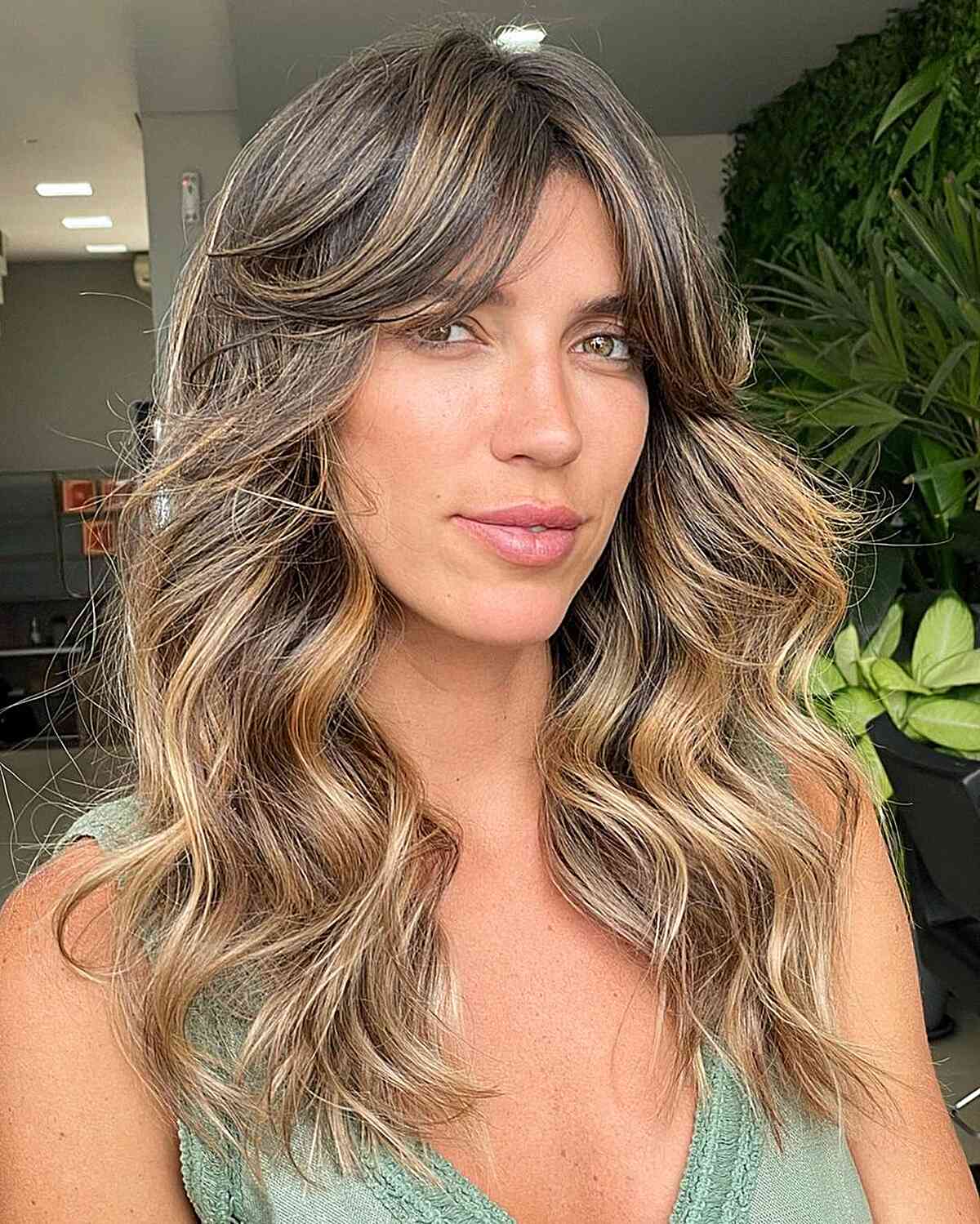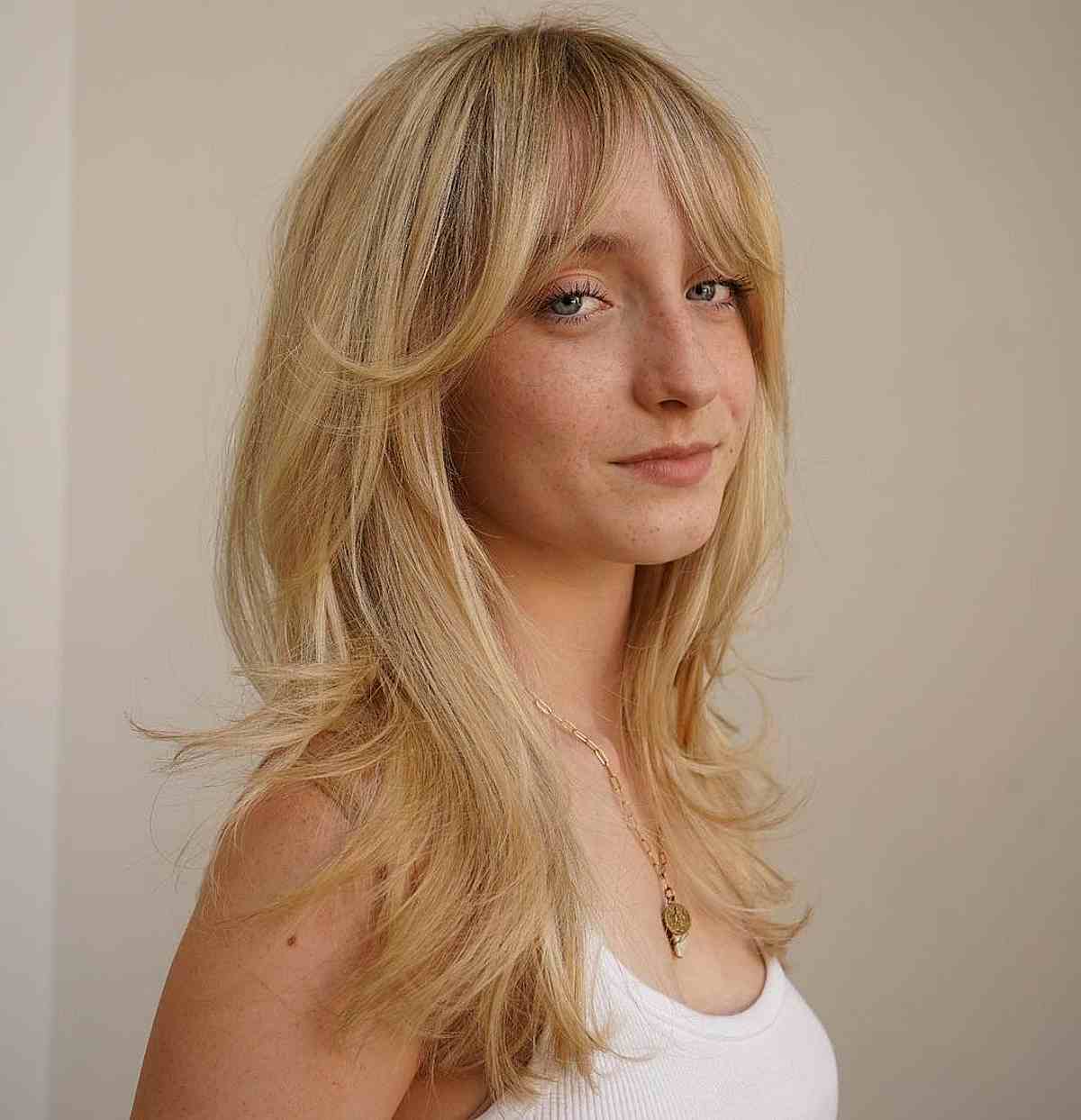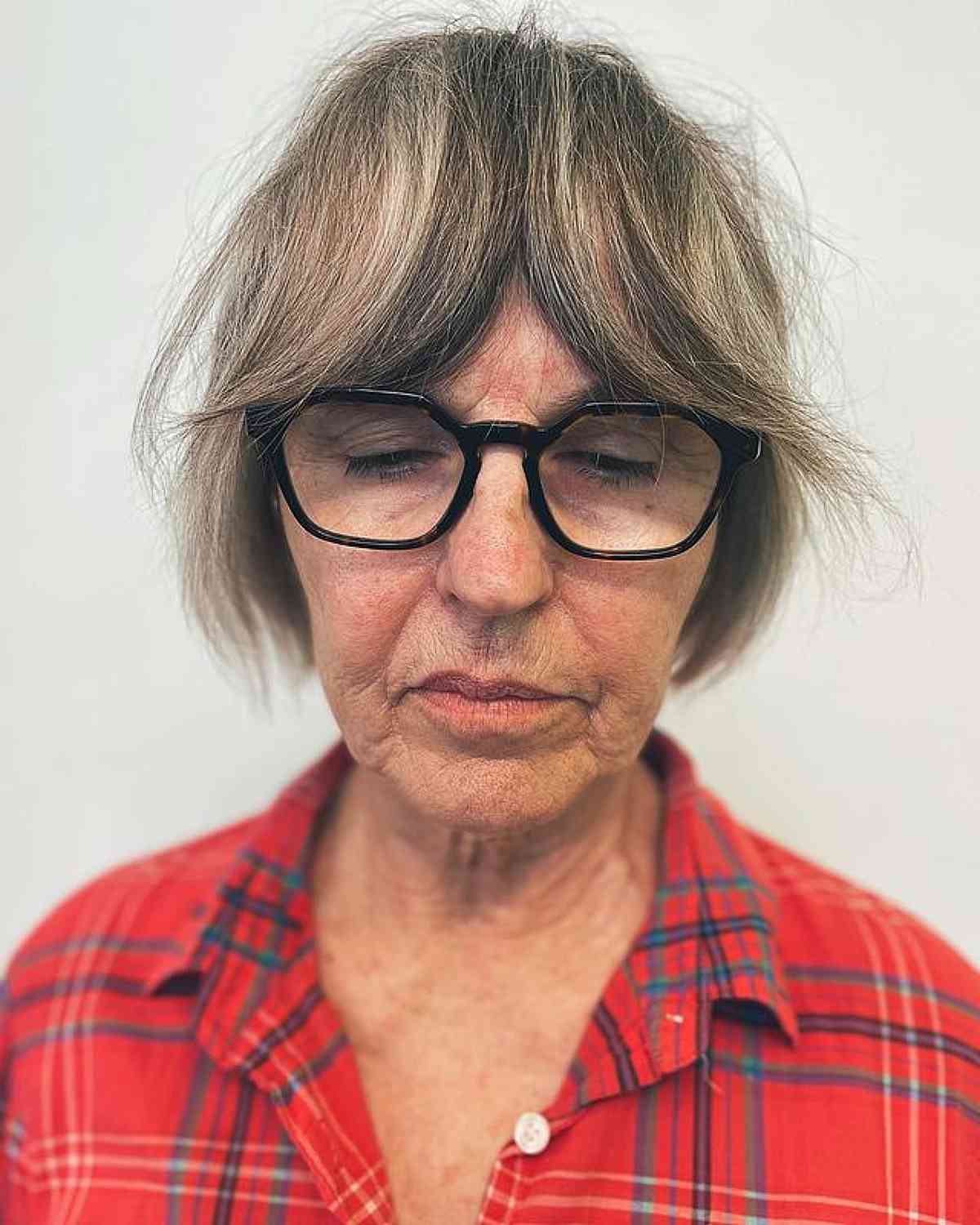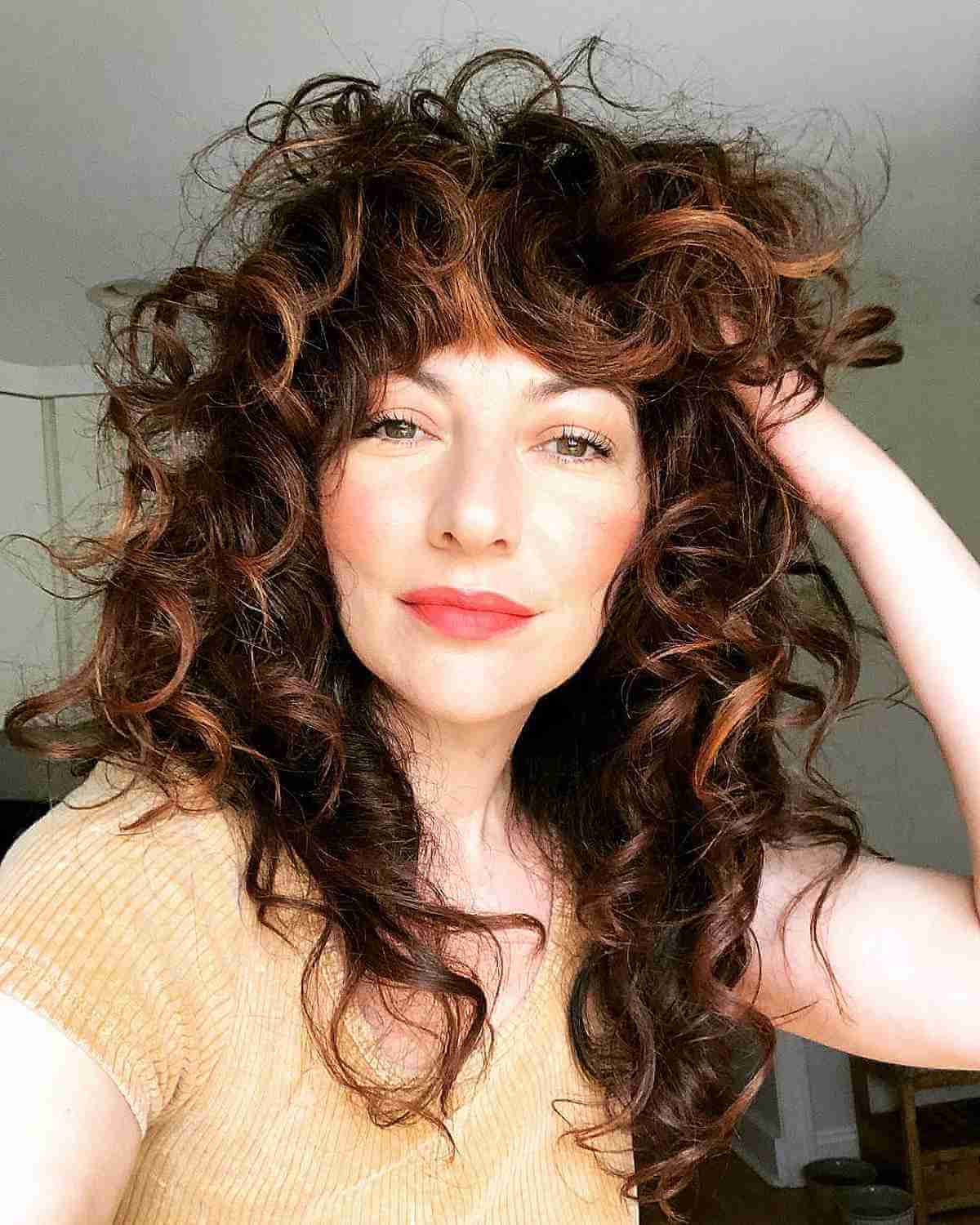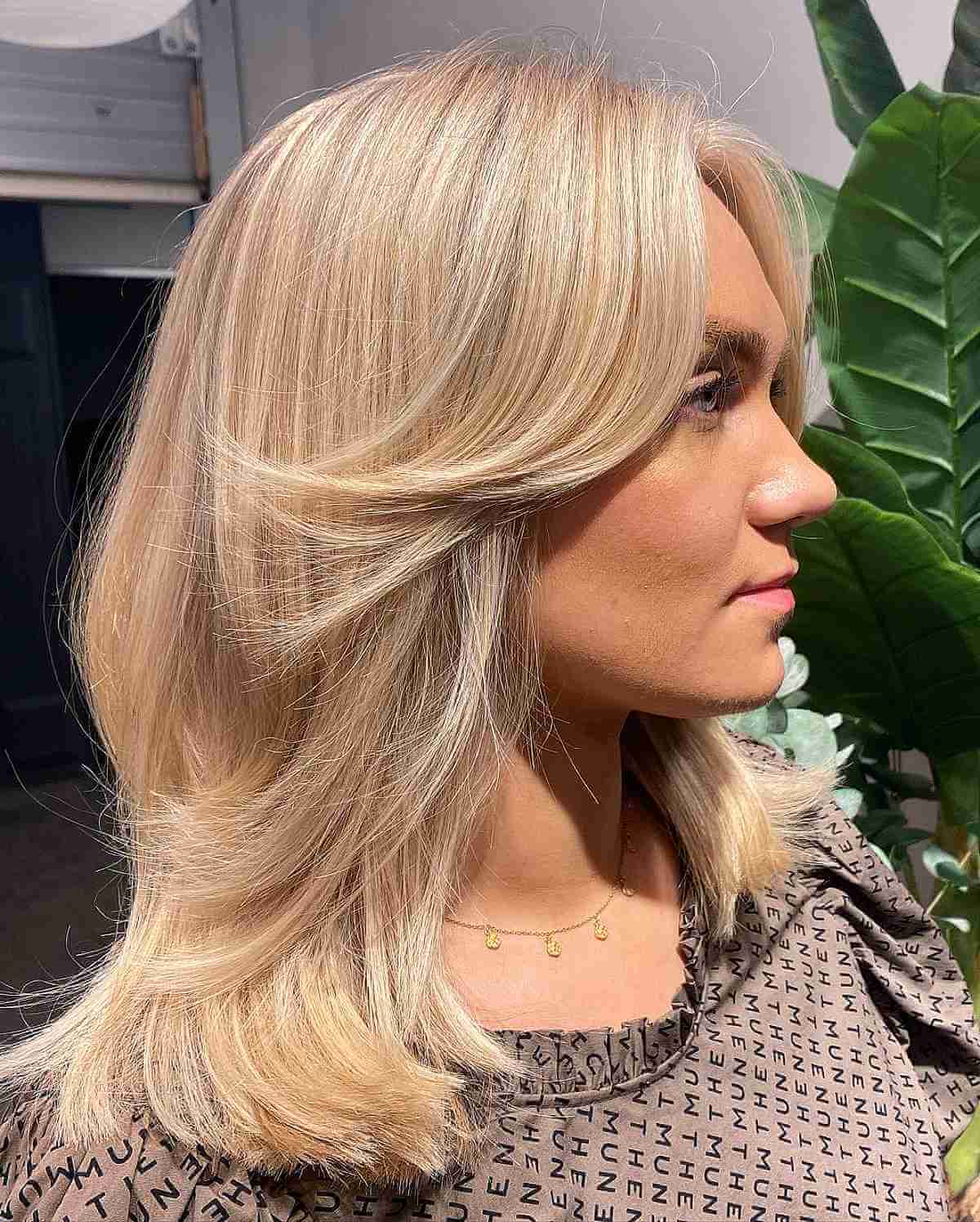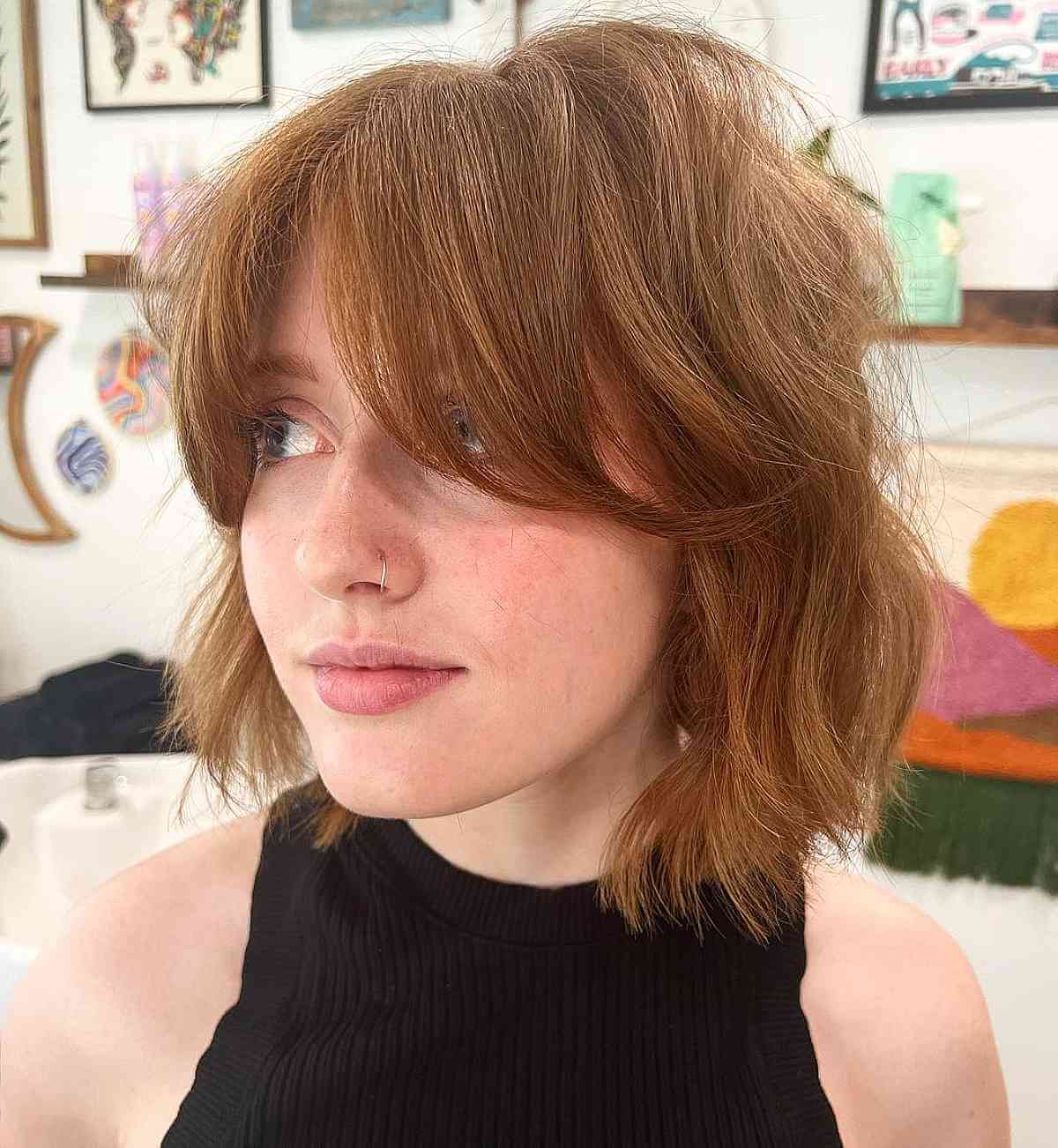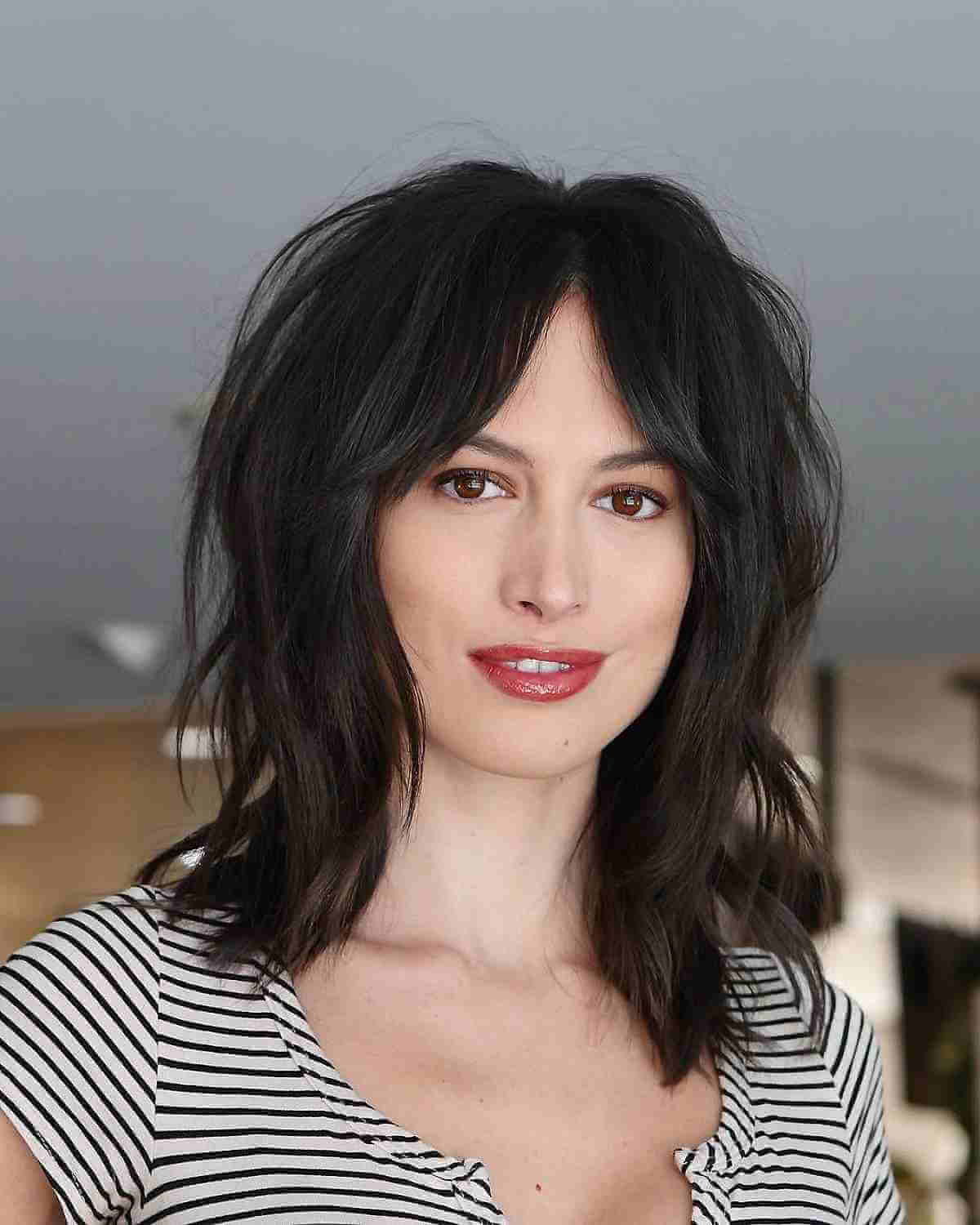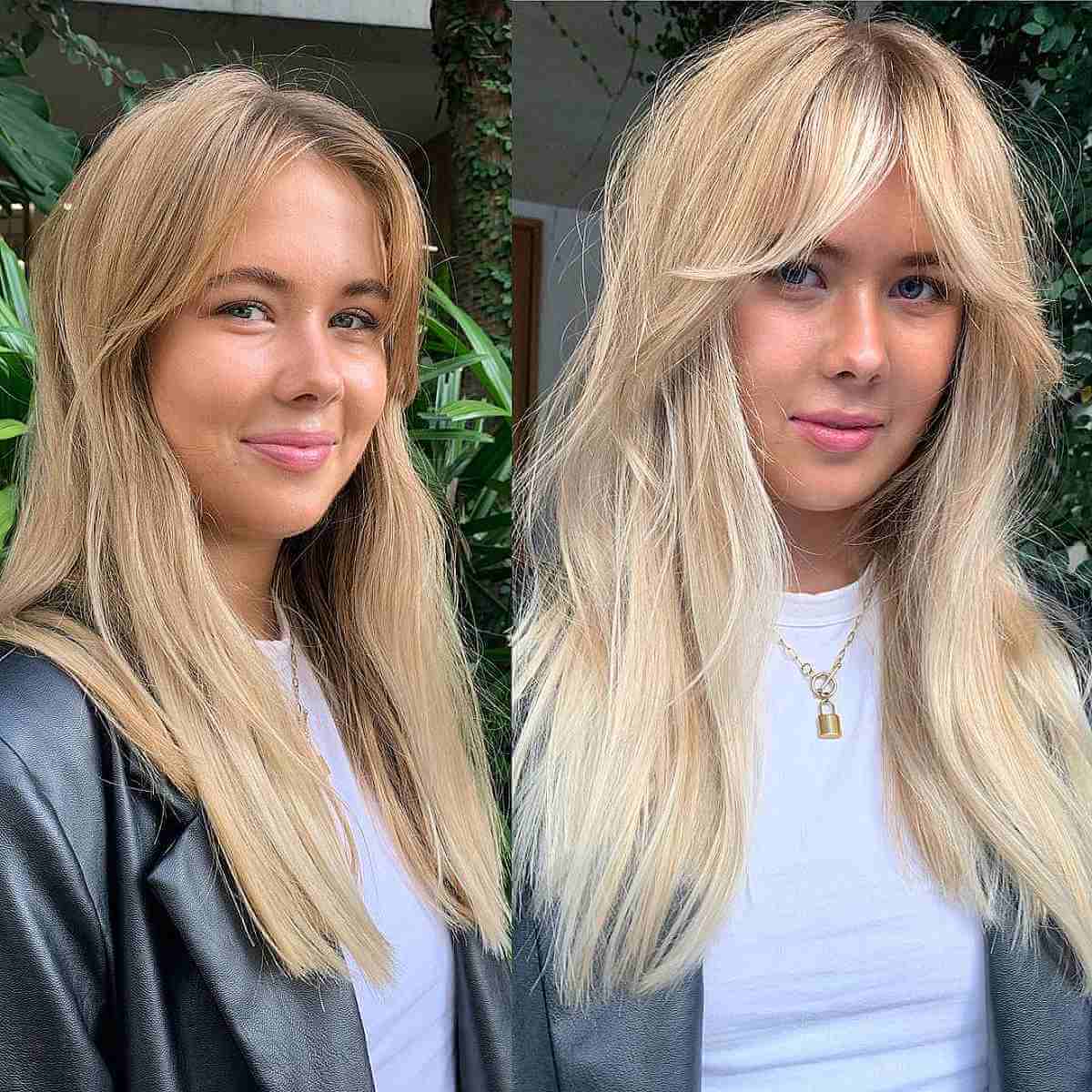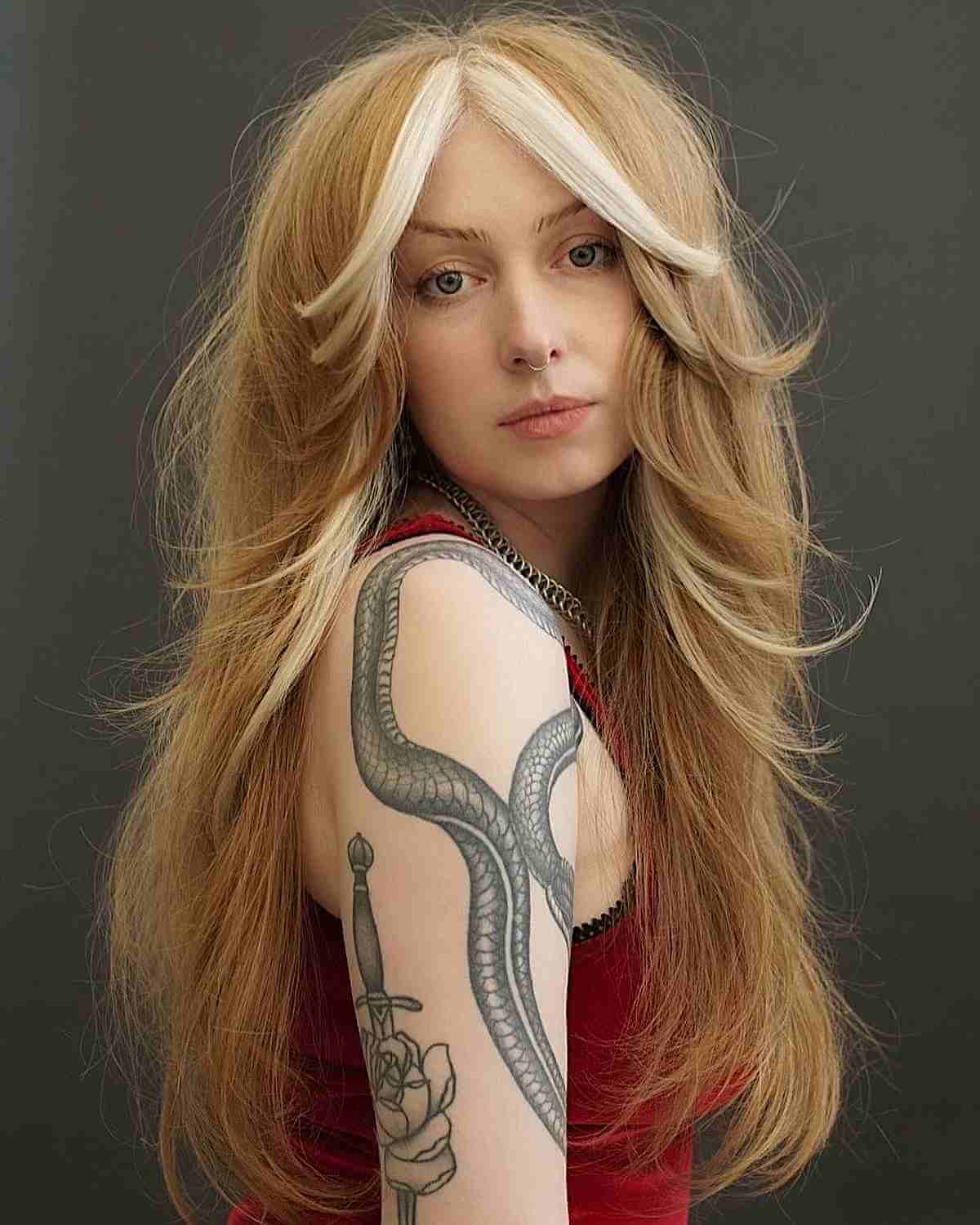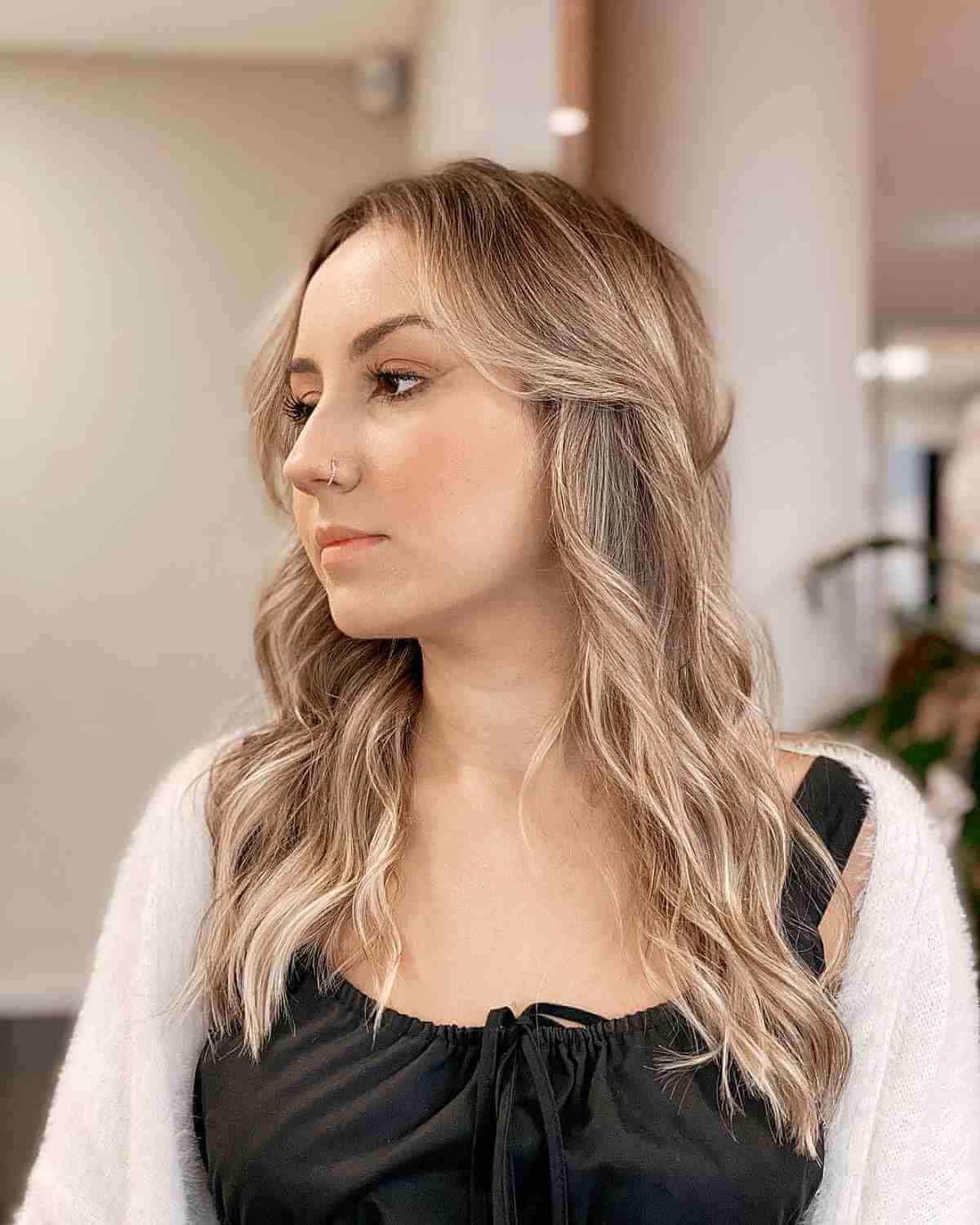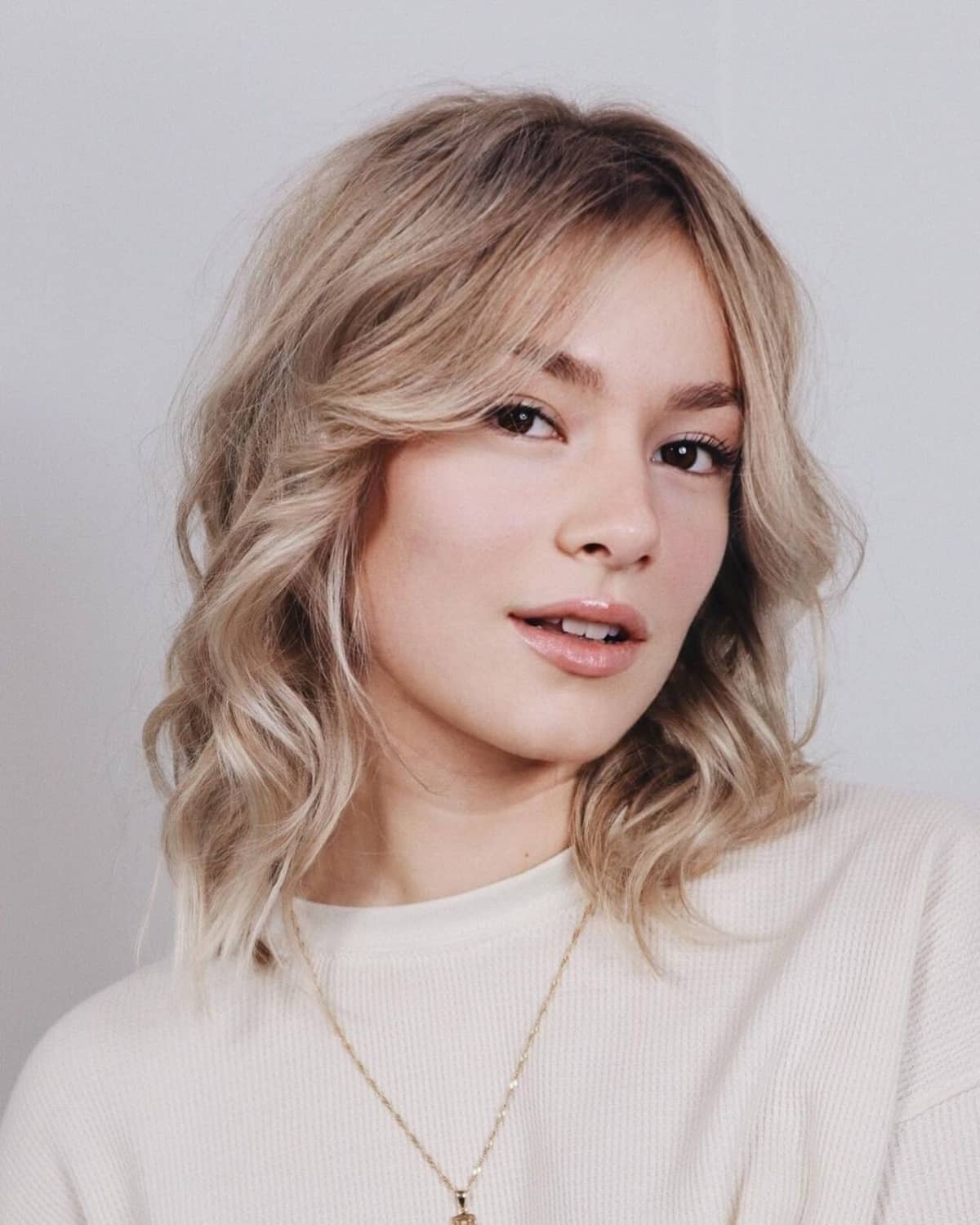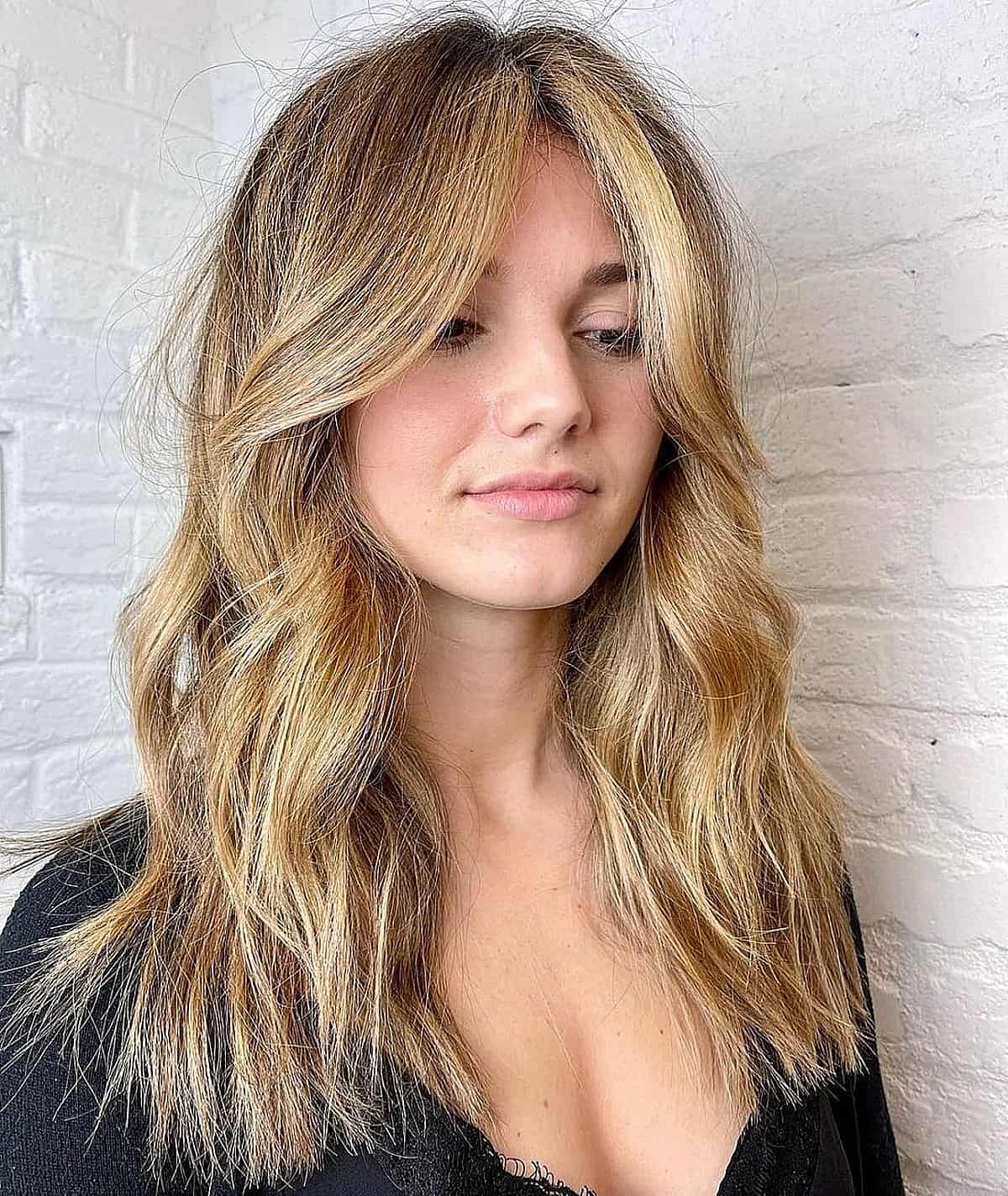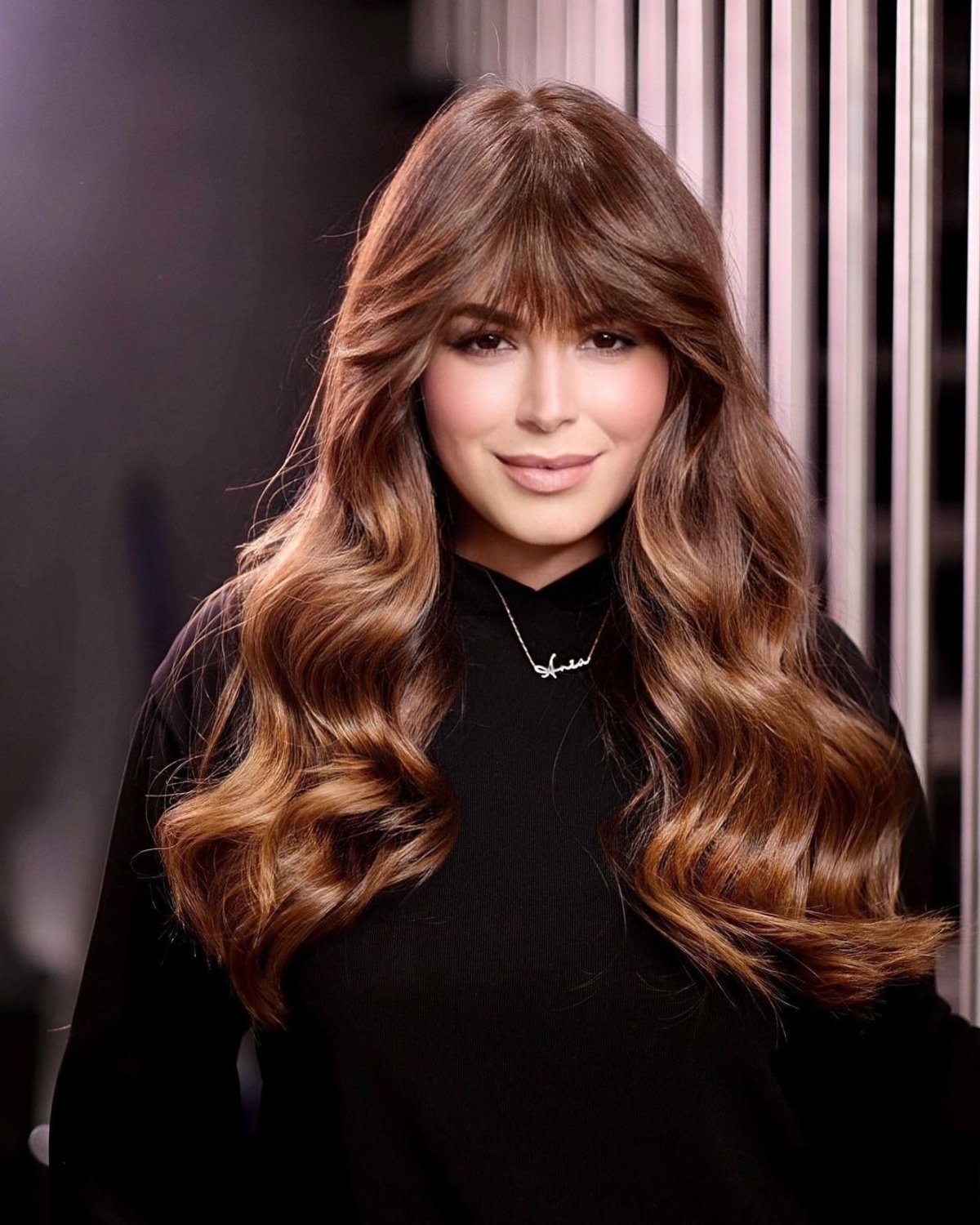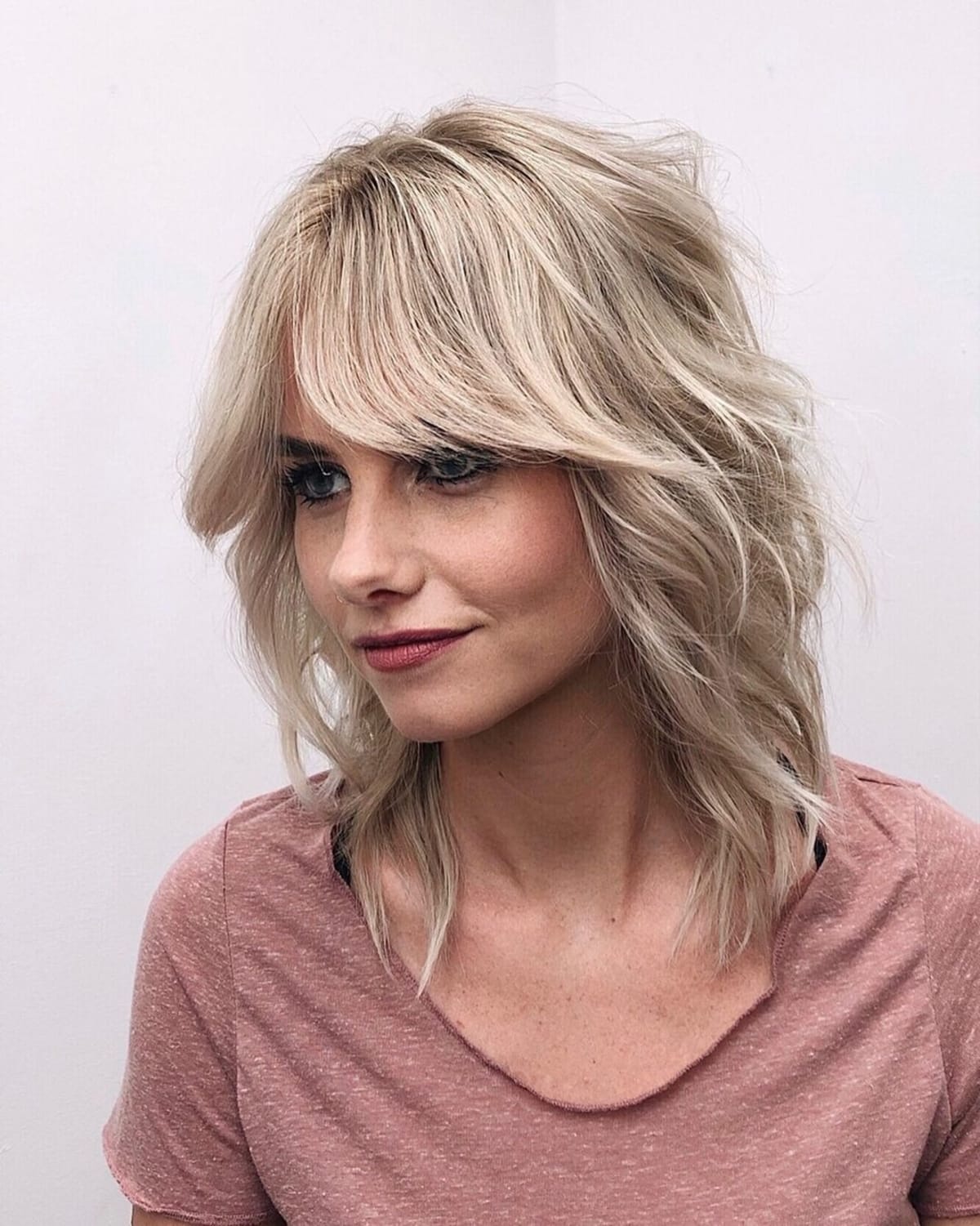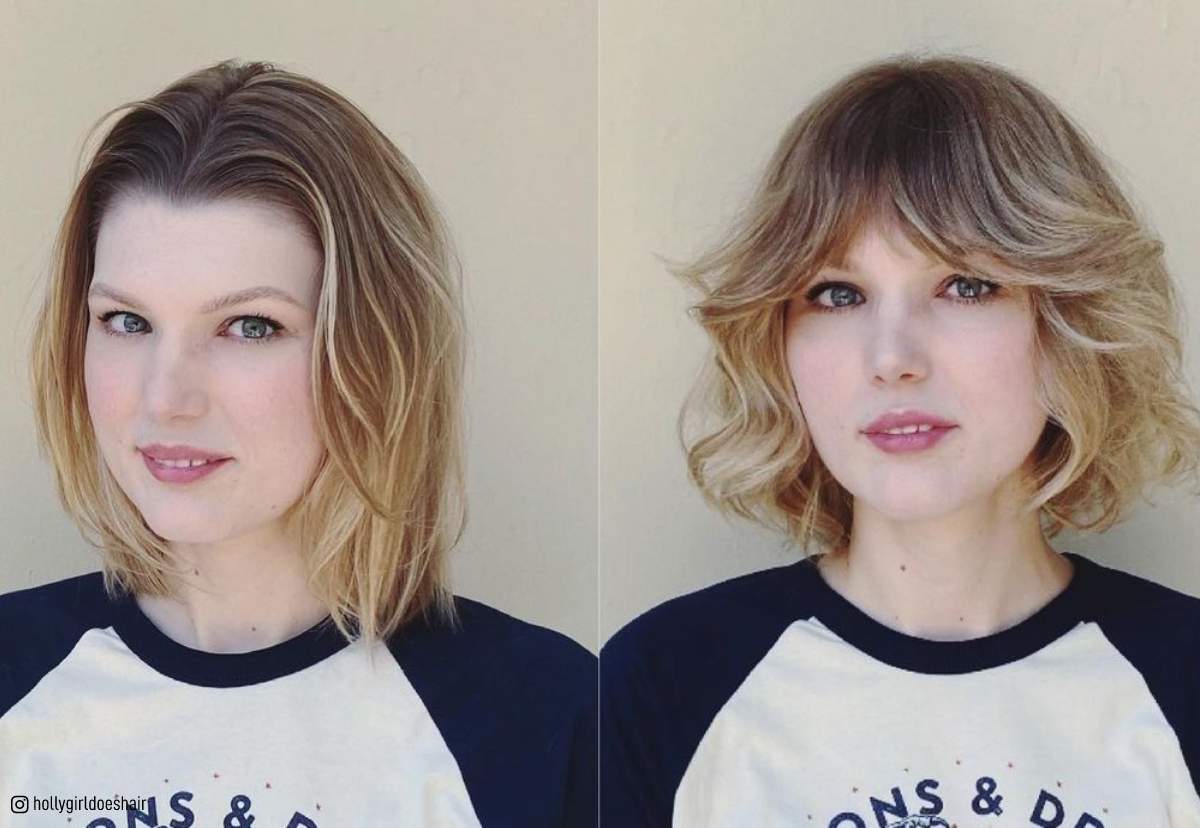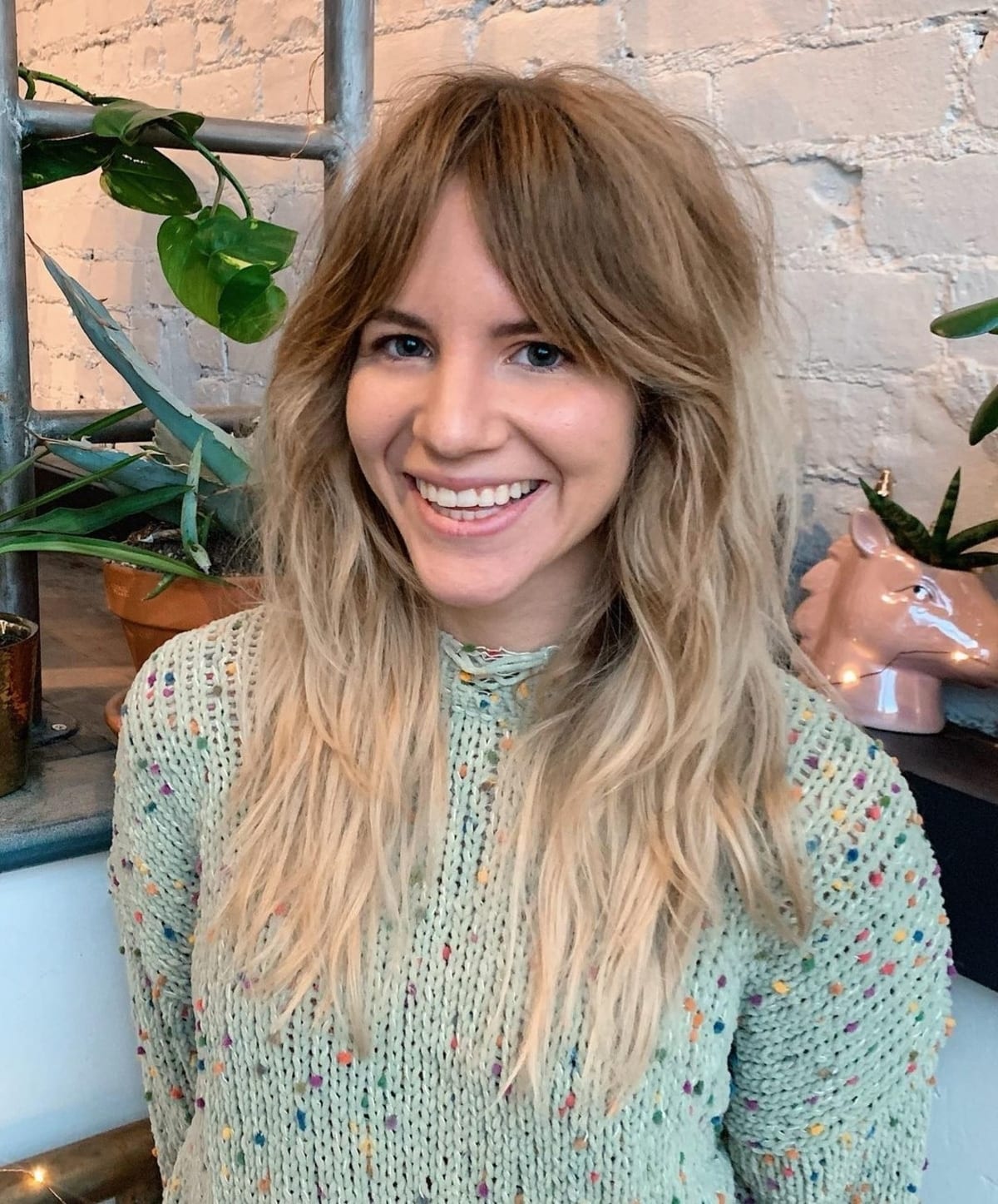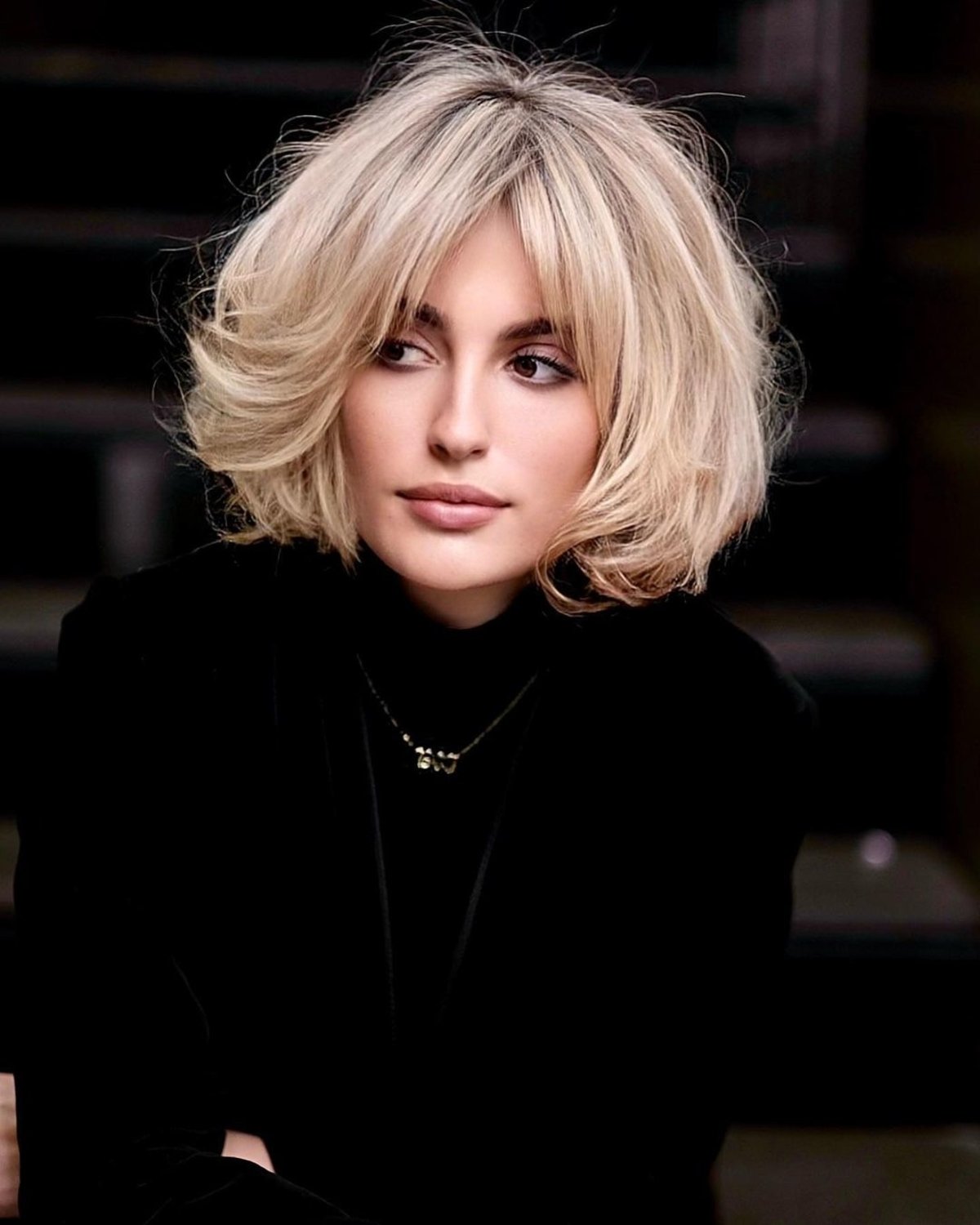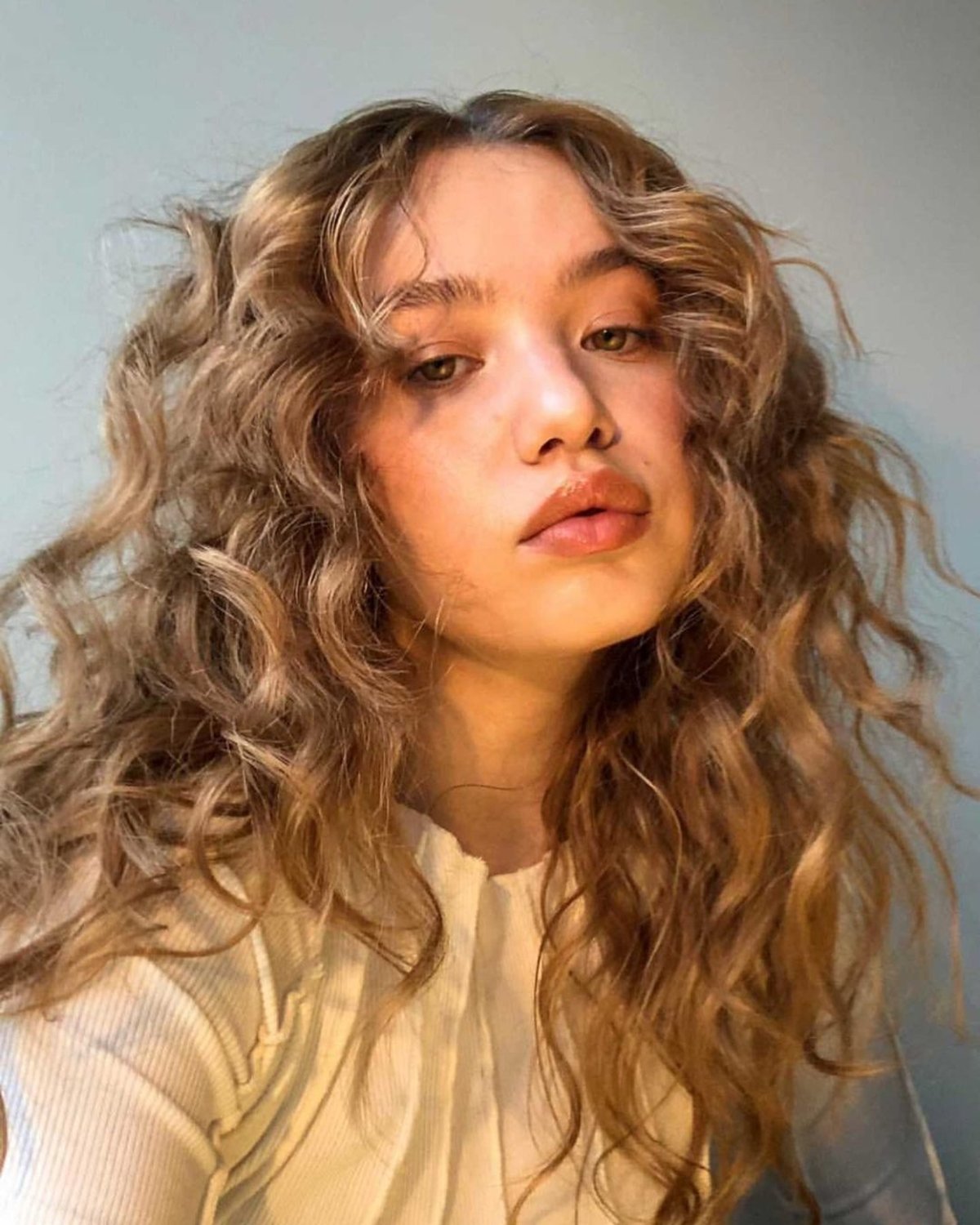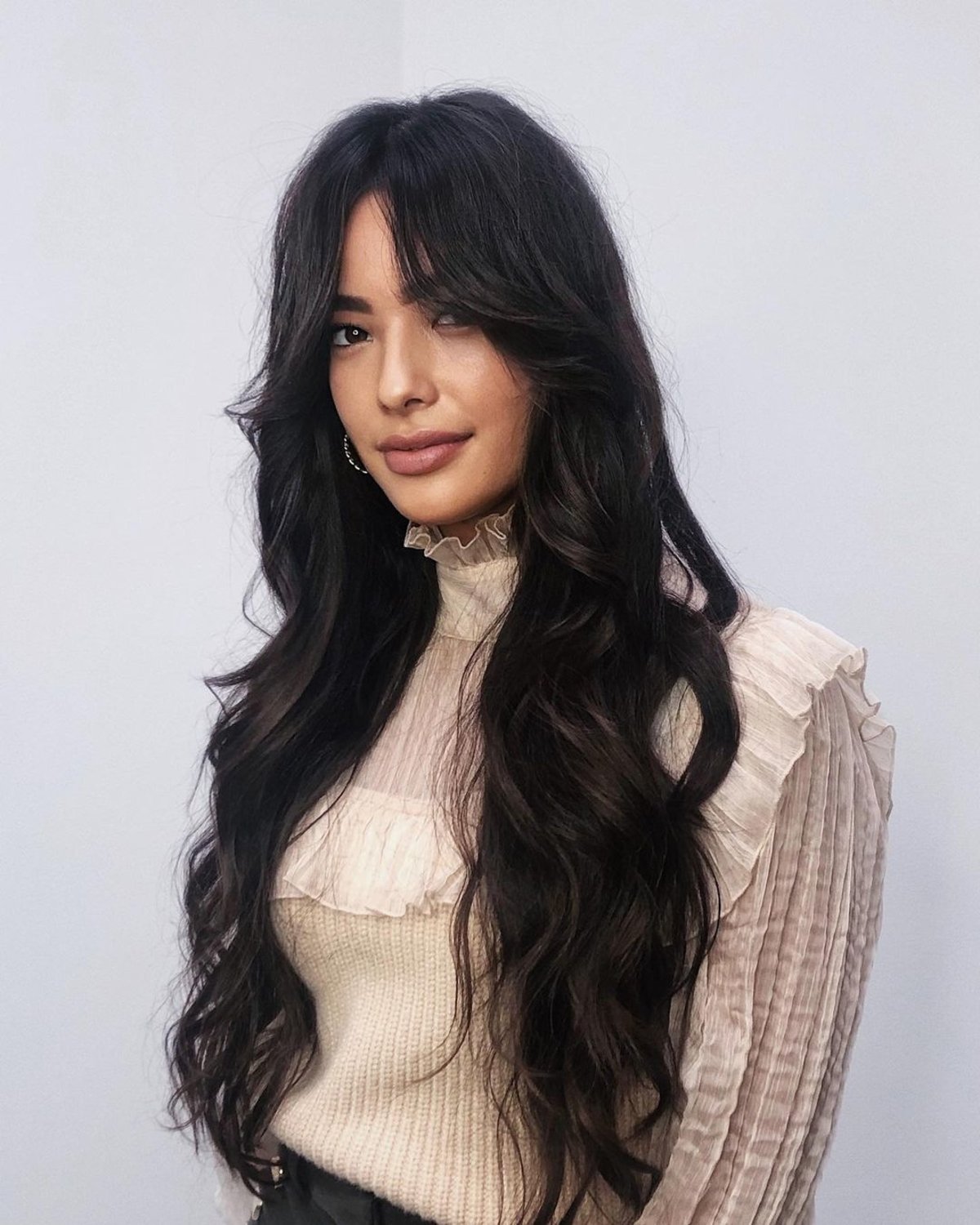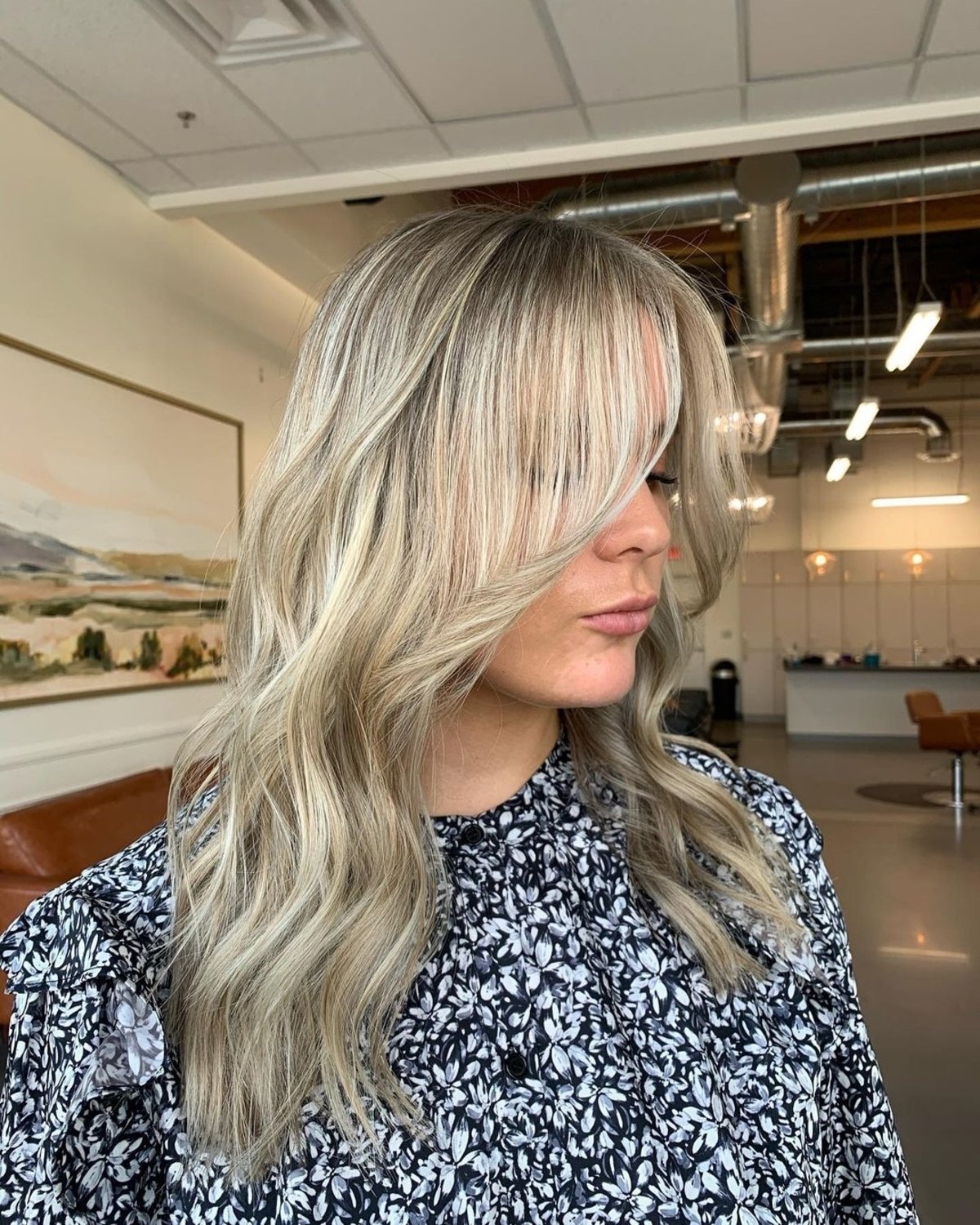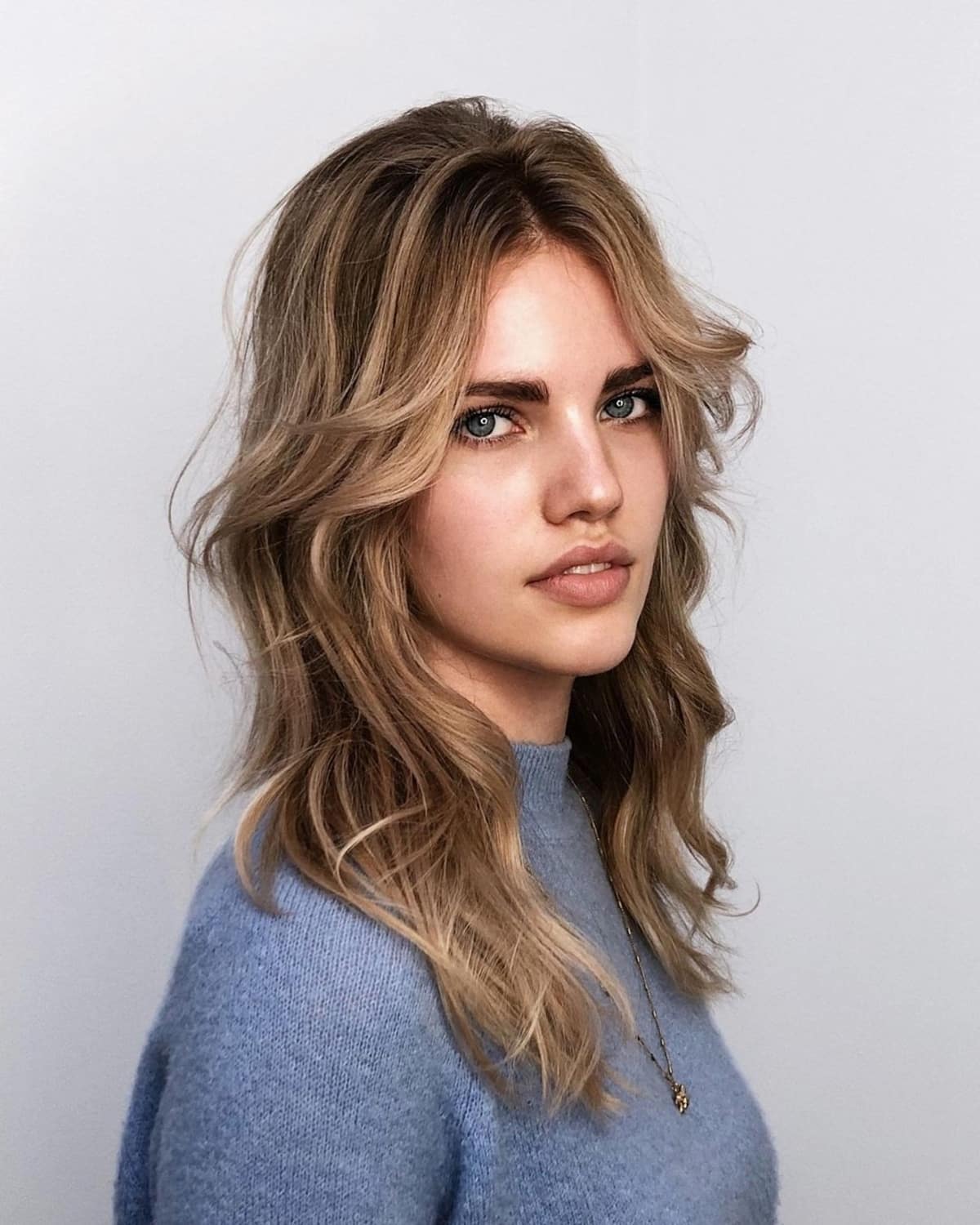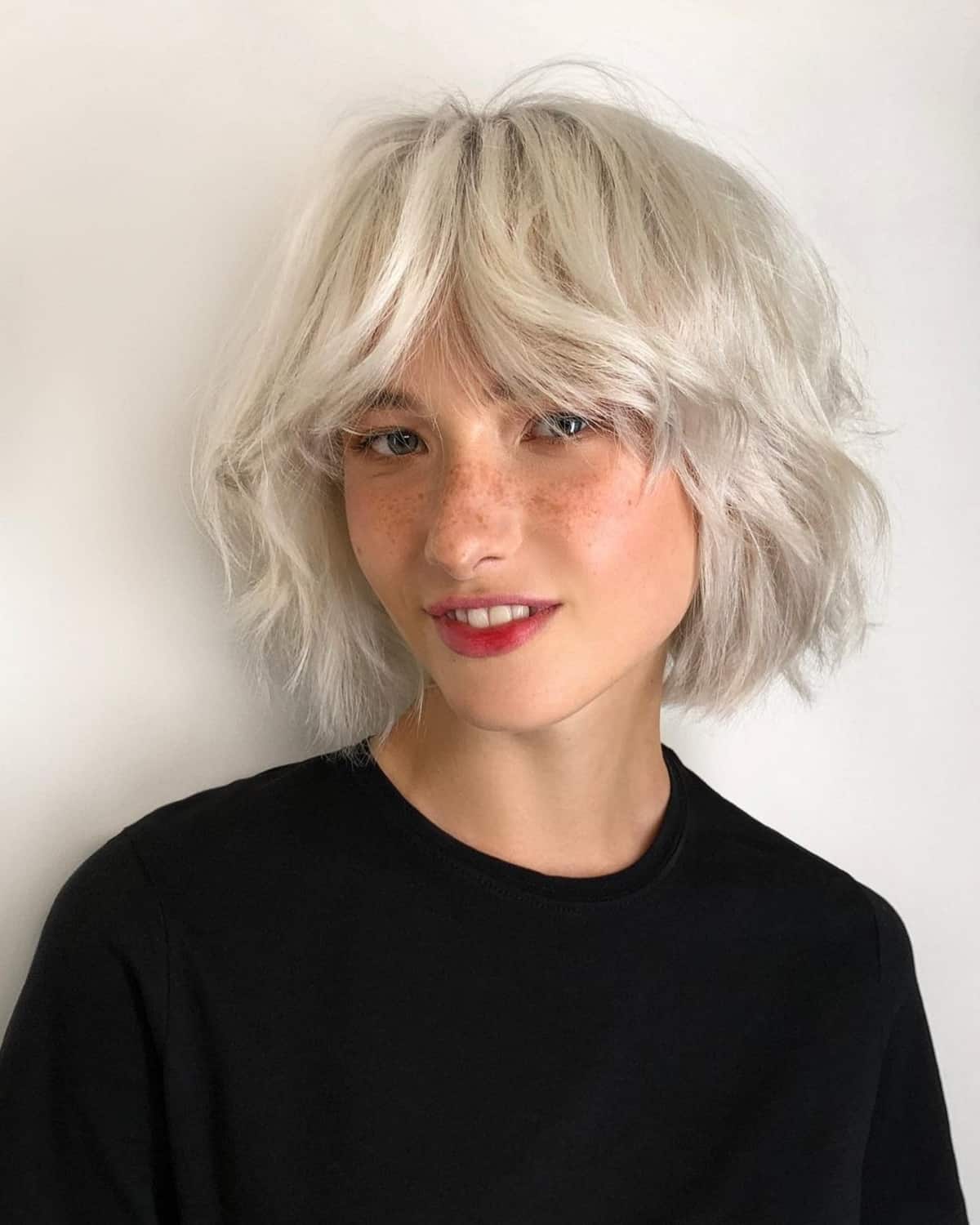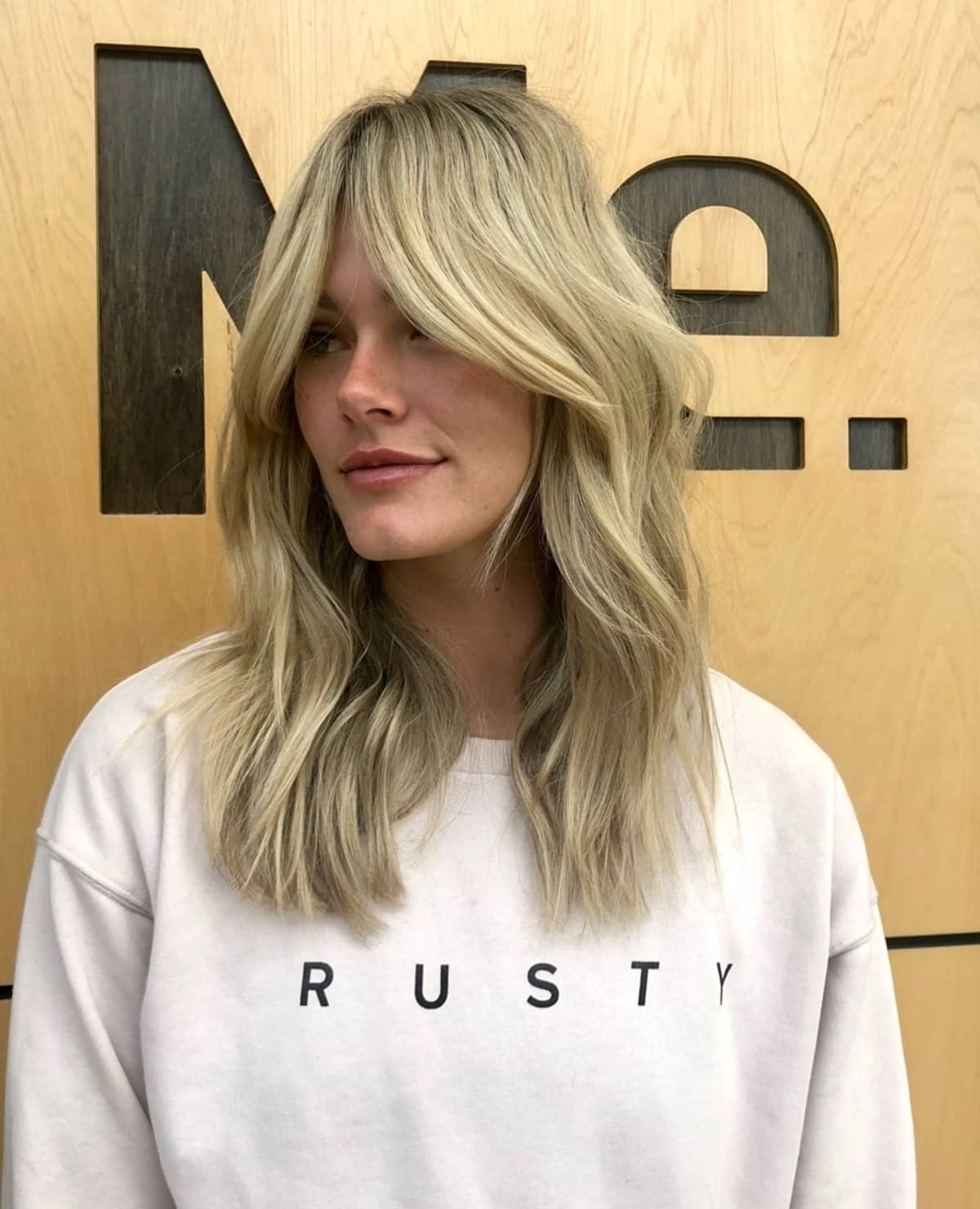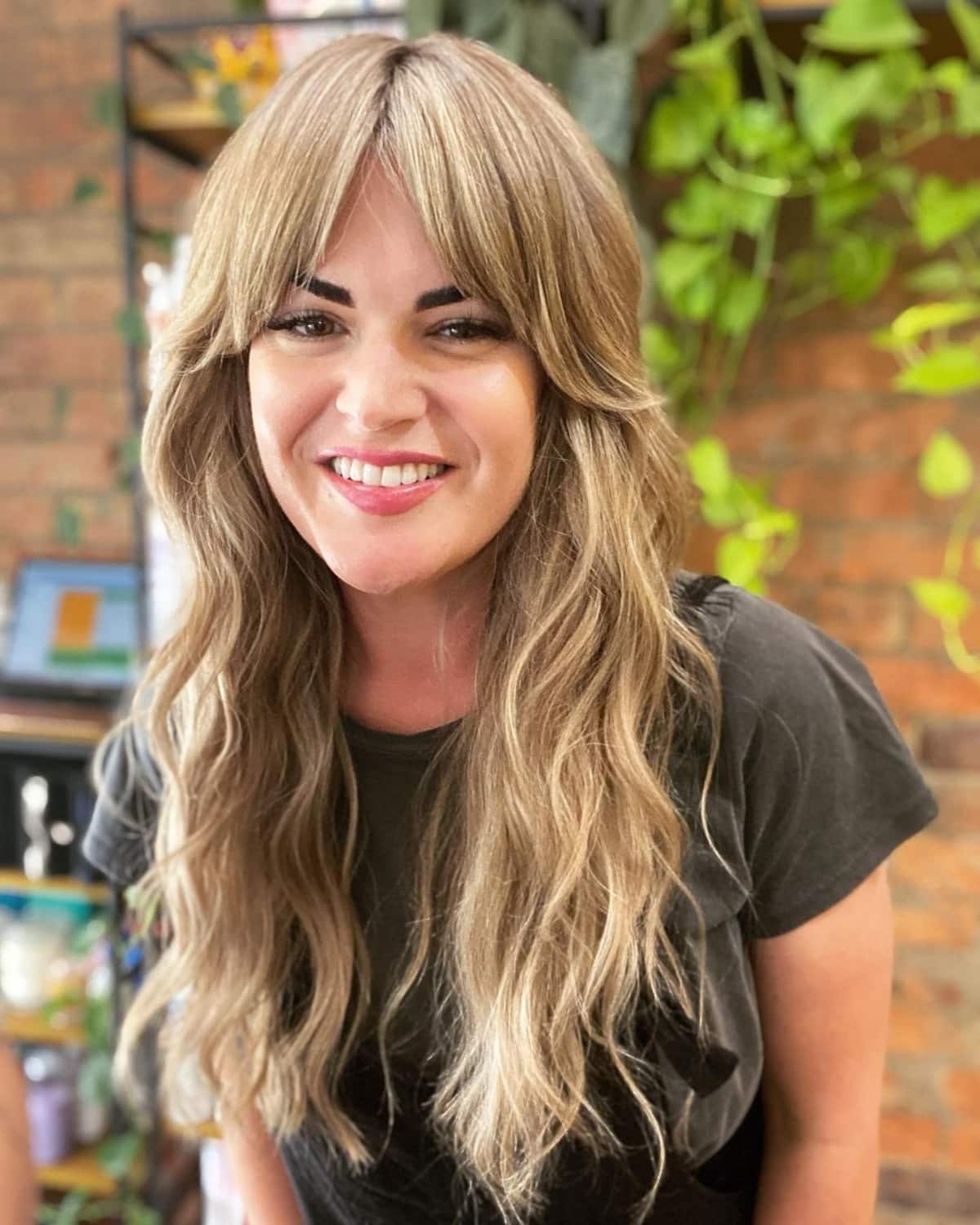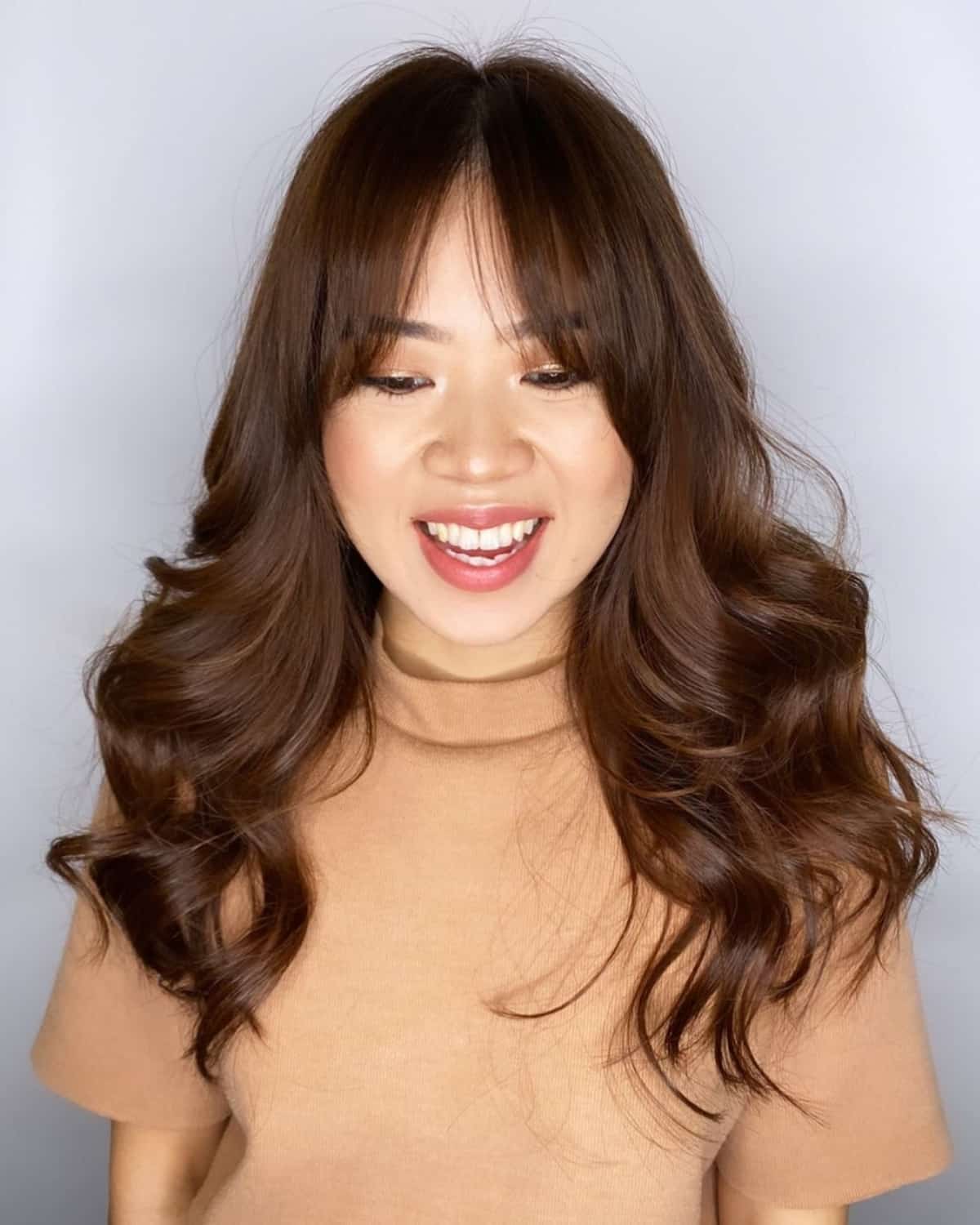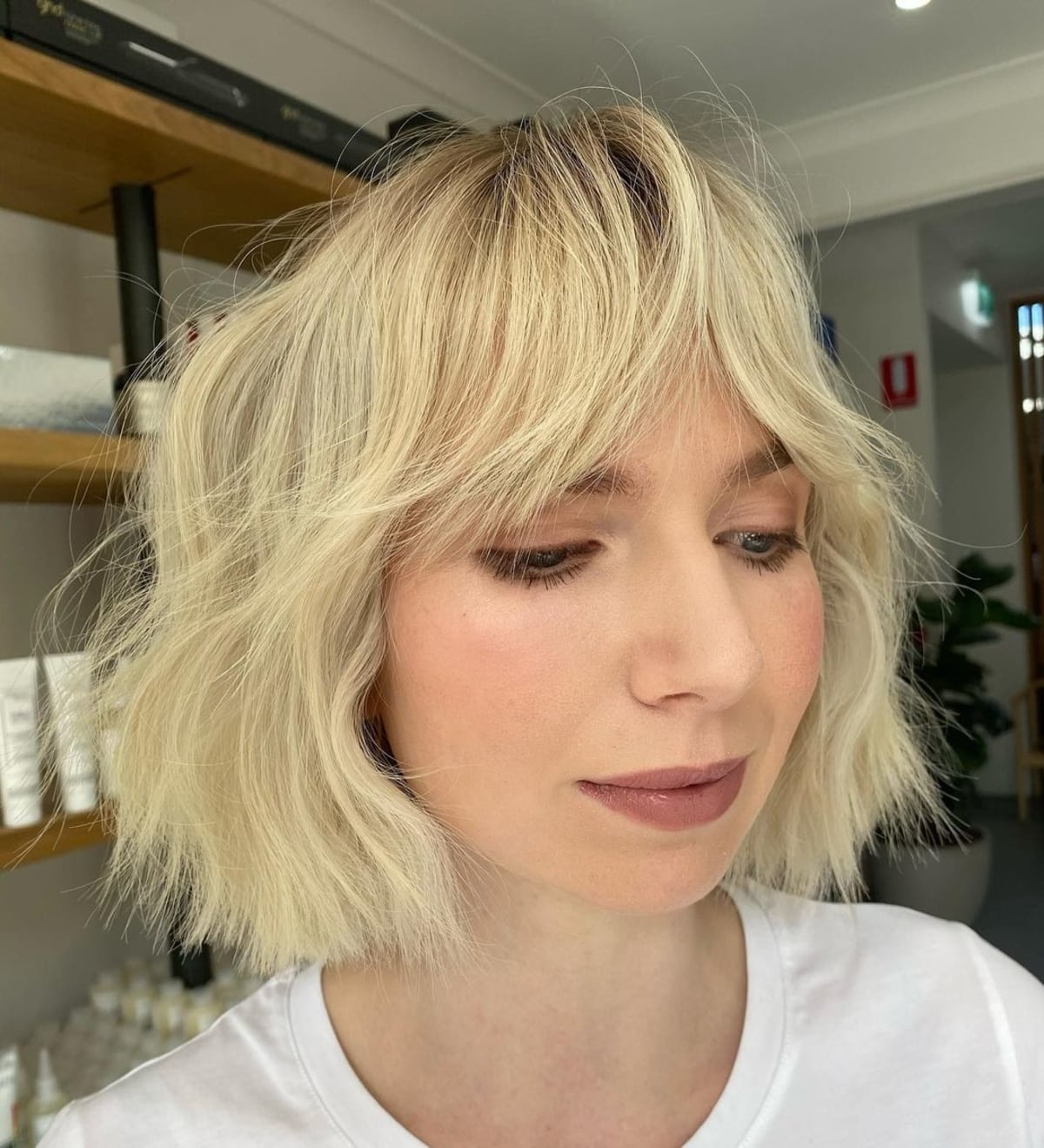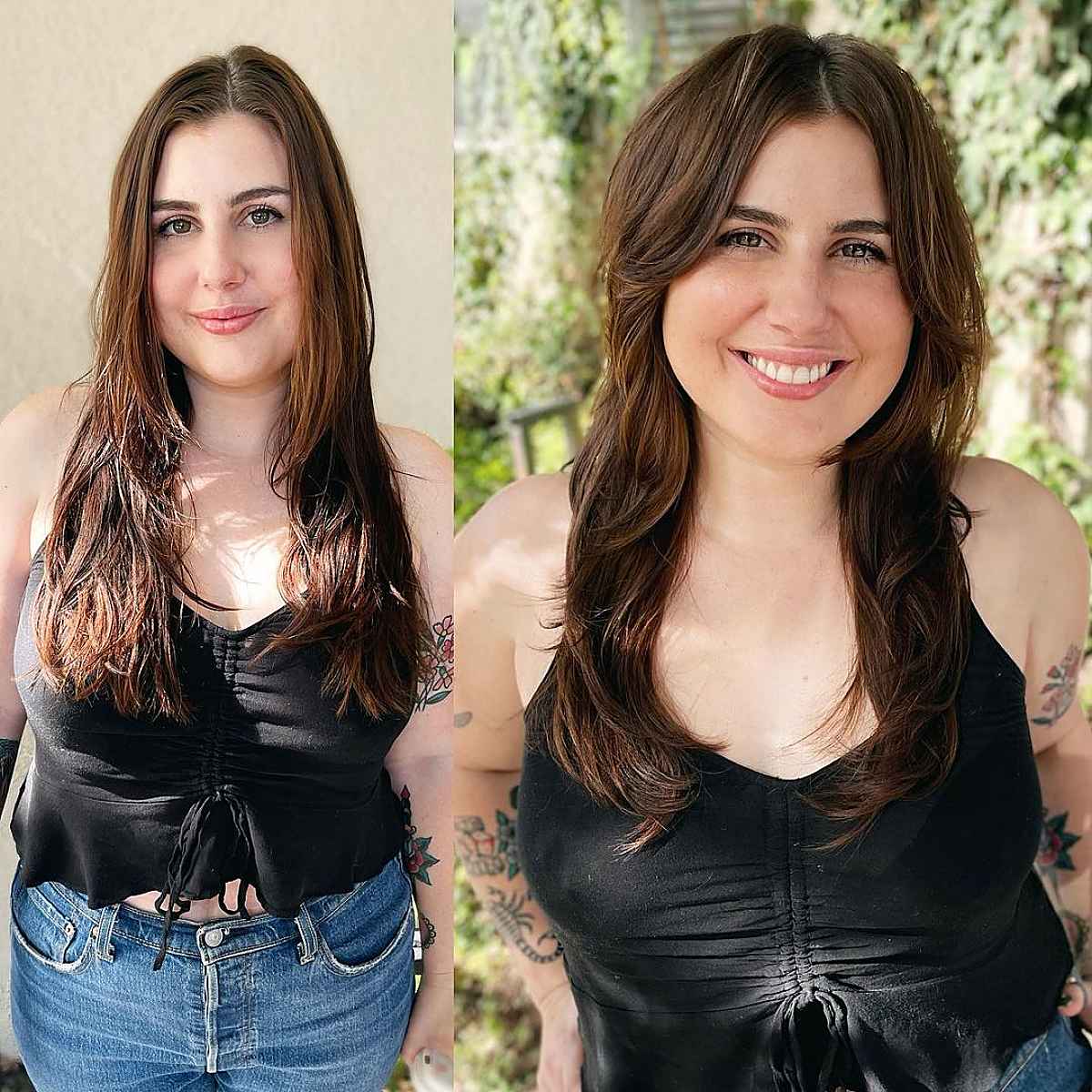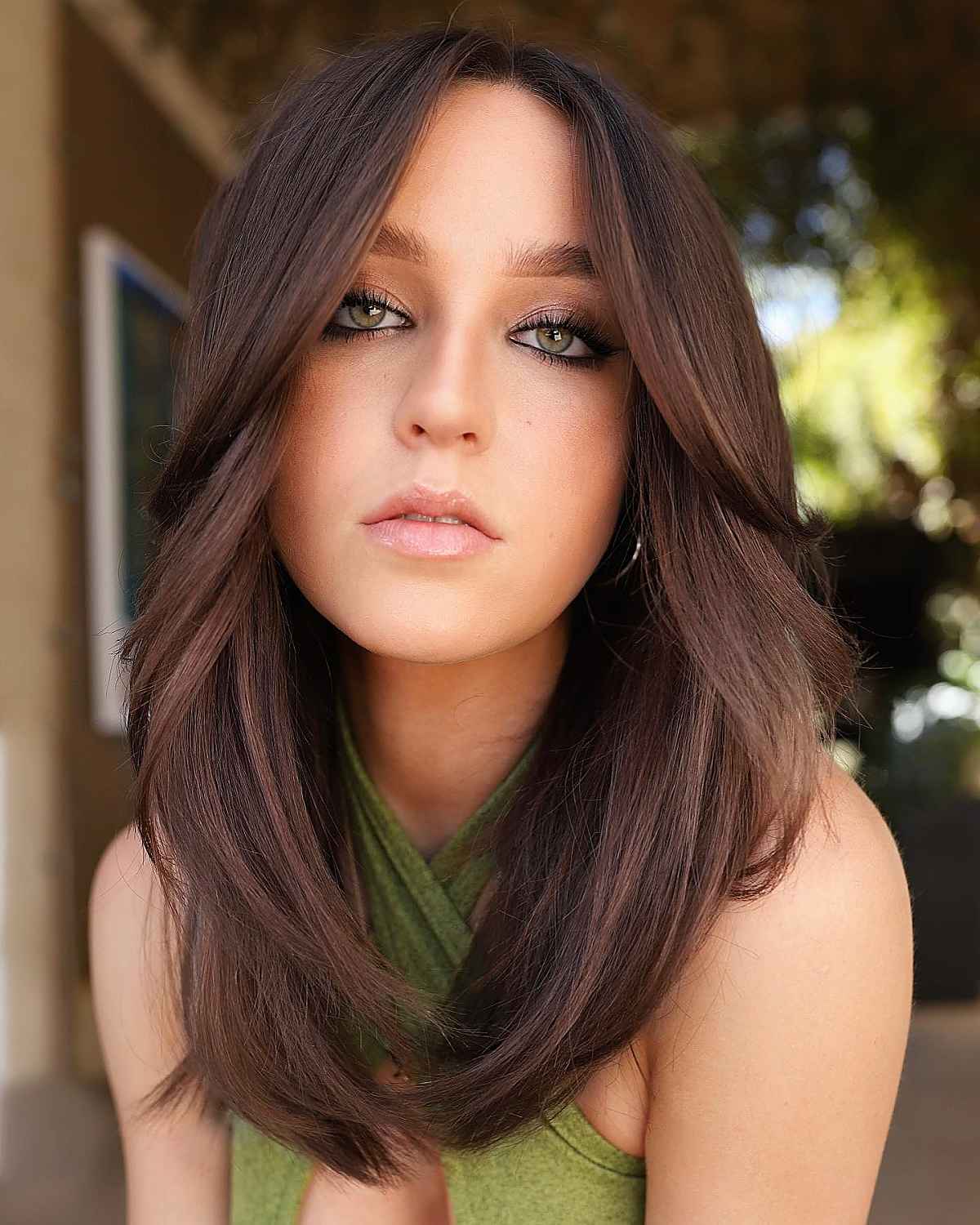Unless you’ve been living under a rock for the past few years, you’ve almost definitely heard all the buzz about curtain bangs. This type of fringe is 100% customizable for absolutely any face shape. It’s no wonder lots of celebrities are rocking these trendy bangs. But before you try out this super-flattering option, several factors are worth considering. That’s why I put together this ultimate guide to curtain bangs—including a gallery full of gorgeous options at the end. Keep reading to learn everything you need to pick the right length and style easily and minimize upkeep!
What Are Curtain Bangs?
Curtain bangs are a type of bangs that are parted in the middle to frame your face. The hair lengths cascade down your cheekbones and jawline, accentuating these features. They gained initial popularity in the 1970s and became popular again in the early 2020s. In the ’70s, many actresses wore their fringe this way. Farrah Fawcett, Goldie Hawn, Diana Ross, and Brigitte Bardot are the most famous examples. (Source) But celebrities today have brought the trend back in a big way! Zooey Deschanel, Hilary Duff, Halle Berry, and Selena Gomez are a few of the many women wearing curtain bangs these days.
Should You Get Curtain Bangs? Here’s How to Tell
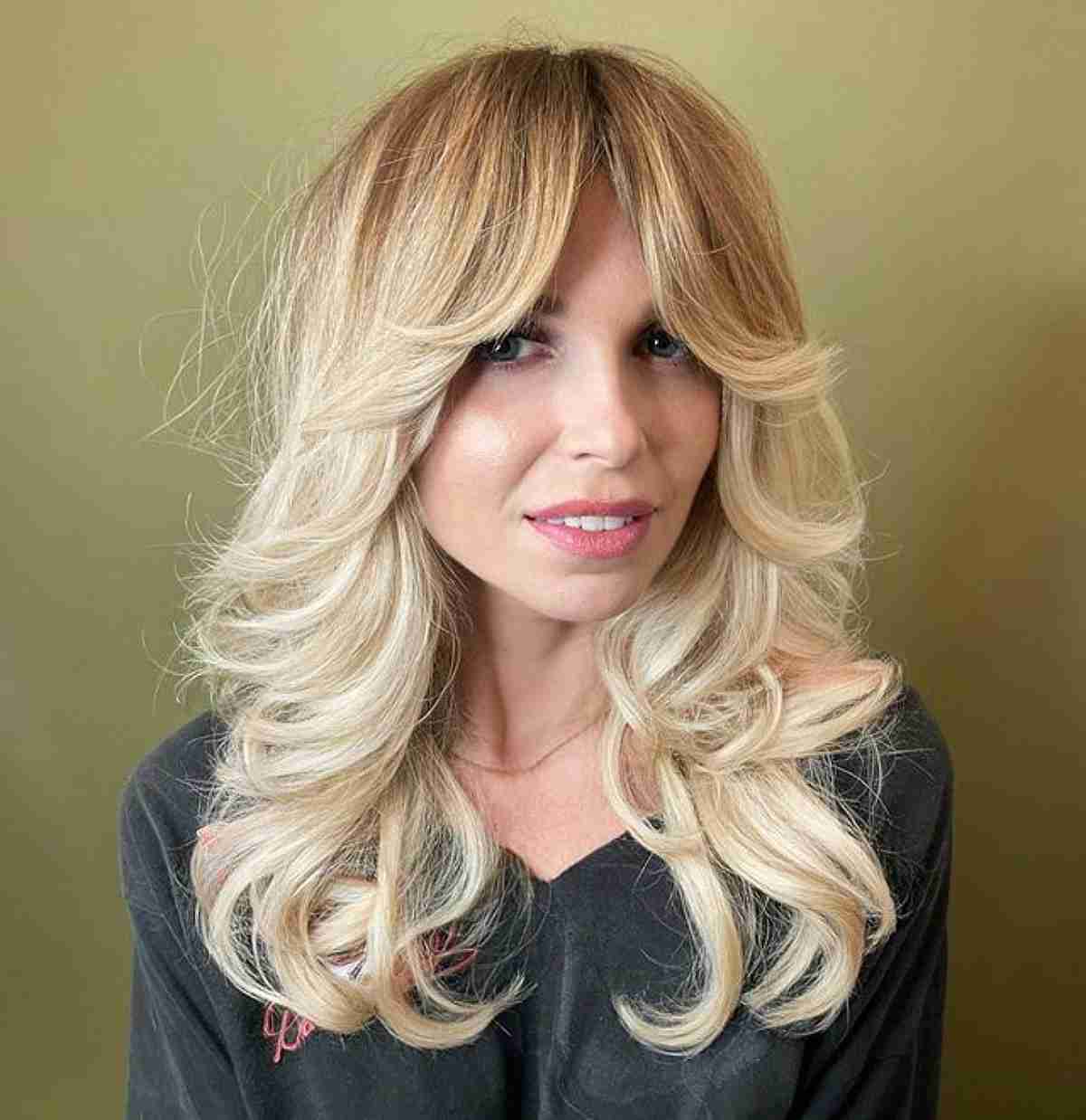
I spoke with hairstylist Brandi Rose of Canada to find out how she helps her clients decide. She said curtain bangs work well for many people because, “as they get longer, you can more easily tuck them behind your ears or push them to the side.”
And I agree! One of my favorite things about curtain bangs is how adaptable they are. Curtain bangs look amazing with long hair, paired with any type of shag, shoulder-length hair, and even short hair. But how do you know if they’re right for you? Consider how much time you have to style each day, how often you’re willing to get bang trims, and your lifestyle.
First, let’s talk about styling. When curtain bangs are cut well, they’ll naturally have the “curtain” shaping—to an extent. I find that I can get away with not blow-drying mine. But if I don’t, I 100% need to spend a few minutes with the flat iron once they’re dry. And sometimes I wash my hair at night. Whether I blow-dry or not, I always need to do touch-ups with a flat iron every morning.
If you don’t have 5-10 minutes each morning for this step, curtain bangs might not be a good choice.
As for bang trims, your stylist can help you set realistic expectations. Discuss how often you’re able to get bang trims. If you want your bangs to always skim your eyebrows, that’ll require visits every month or two. But if you’re happy to wear your bangs grown out, you can get trims every 2-4 months. I know how much your lifestyle might impact your ability to style daily or get trims. If you’re a busy mom or professional, you might want to start with longer curtain bangs. These are a little faster to style and need trims less often. But if you’re retired (or have a flexible schedule for any reason), you can go for a shorter version. In a nutshell, all types of curtain bangs need a bit of daily upkeep and occasional trims. So, talk with your hairstylist about your schedule. They can customize your fringe to fit nicely into your routine.
The Pros of Getting Curtain Bangs
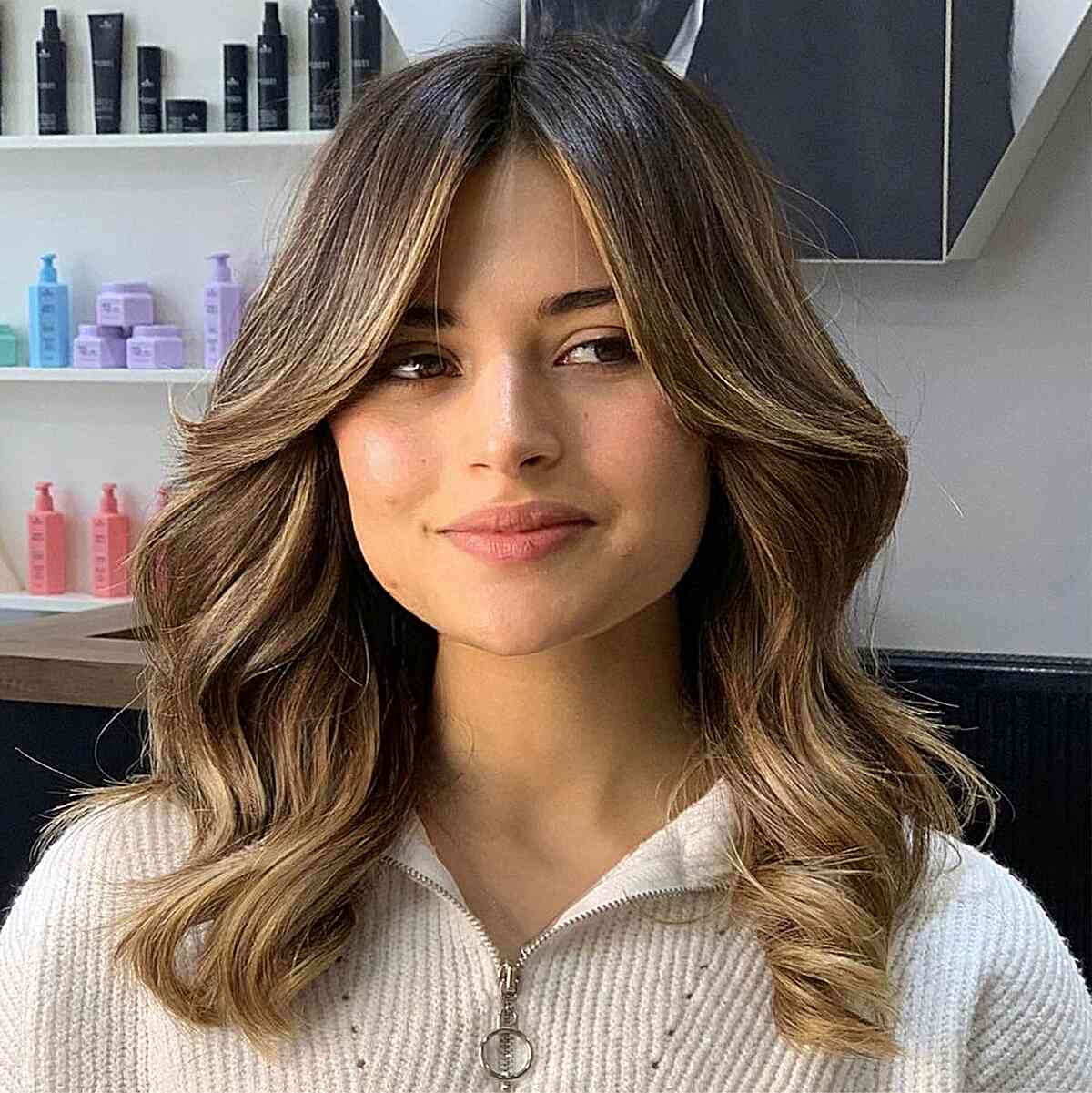
- Chic appearance. You can style curtain bangs in a few different ways. But no matter which you choose, you’ll look effortlessly chic.
- Less commitment. Curtain bangs gradually get longer through the sides, unlike other types of fringe. This makes them very easy to grow out and less of a commitment than other bangs.
- Look youthful. This option is excellent because your forehead is mostly covered, hiding any fine lines. But curtain bangs are versatile enough that you won’t look like you’re trying to hide your age.
- Customizable. Most types of bangs are best suited to a specific face shape. But curtain bangs can be customized endlessly, meaning any face shape can rock them.
The Cons of Getting Curtain Bangs

Every hairstyle will have a few potential downsides, including curtain bangs. Here’s what you should be aware of:
- Hair lies on your forehead. You may get breakouts or feel like your forehead is extra oily because your bangs cover it all day. Carry oil-blotting wipes with you if you’re set on curtain bangs but worried about this.
- Different effect on curls. Your stylist can give you curtain bangs even if you have curly or coily hair. But the effect doesn’t happen on these hair types. You’d have to either blow-dry your bangs every day or accept that your curtain bangs won’t frame your face quite the same way.
- Weather can be annoying. You’re likely to notice your forehead sweating on bright, sunny days. And on windy days, the breeze will dishevel your style. A good hairspray can help with the latter, though.
Hair Type Considerations
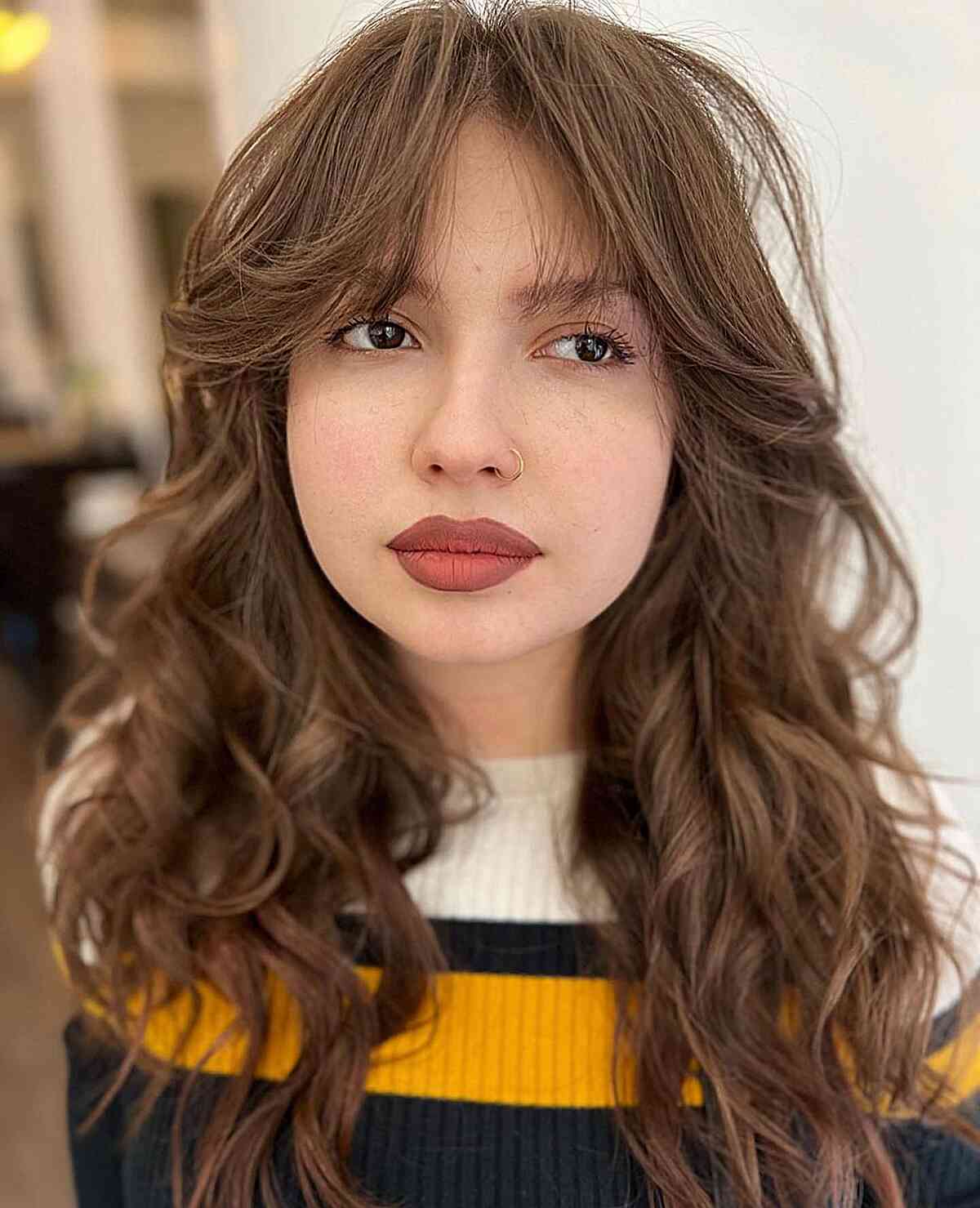
As I mentioned, curtain bangs can look very different if you have curls. But that’s not the only hair type consideration to make. Below are the most important things to keep in mind for each hair type. If your specific hair type isn’t listed below, you won’t have extra factors to consider. All you need to remember is your face shape and your desired level of upkeep.
Straight, Fine, or Thin Hair
Curtain bangs can be great for naturally straight, fine, or thin hair. They add a lot of volume and movement. But unlike blunt or swoopy bangs, you won’t need to give up a huge section of hair on top to get these effects. And as they grow out, curtain bangs look more like face-framing layers. This also creates a lot of texture and the illusion of thicker hair. So even if you’re past due for a bang trim, your hair will still look naturally voluminous. The one thing to keep in mind is that you’ll need daily styling to get maximum volume in this type of fringe. You can mist them down with a bit of water and blow-dry, or use a flat iron to give them a lift. If your hair is pin-straight, you may also want a volumizing hairspray to hold the shape.
Curly or Coily Hair
Curtain bangs lay differently on curly and coily hair types. Usually, your hair won’t have the typical “curtain” parting. It’s more likely that your entire forehead will be covered, or very little will be. It all depends on your unique curls or coils. But that’s not to say curtain bangs would look bad on you! They can be the easiest to style when you have coils or curls since you just have to scrunch and/or diffuse. The best tip I can give you is this: find a picture (or pictures) of curtain bangs on a texture that closely matches yours. This will give you a very realistic idea of what to expect from yours. You may also want to see a stylist who specializes in your hair type. I say this because curls and coils shrink up so much when they’re dry versus wet. An inexperienced stylist may cut them too short. When you book your appointment, ask if anyone there is a specialist or even certified to cut curls.
Thick or Coarse Hair
With thick and coarse hair, it can be hard to create natural-looking movement. If you have this hair type, your curtain bangs will need a lot of layering and texturizing. Luckily, there are many ways to achieve this. Razor-cut curtain bangs will offer that chic feeling. They’ll also remove lots of weight and bulk. Asking for layers in your curtain bangs and/or point cutting through the ends can make a big difference too. If yours end up too heavy, you’ll find yourself struggling to style them. You’ll also feel like you already need a bang trim. Feel free to specifically ask for layered, texturized, or wispy curtain bangs to ensure you get a good result.
Customizing Curtain Bangs for Your Face Shape
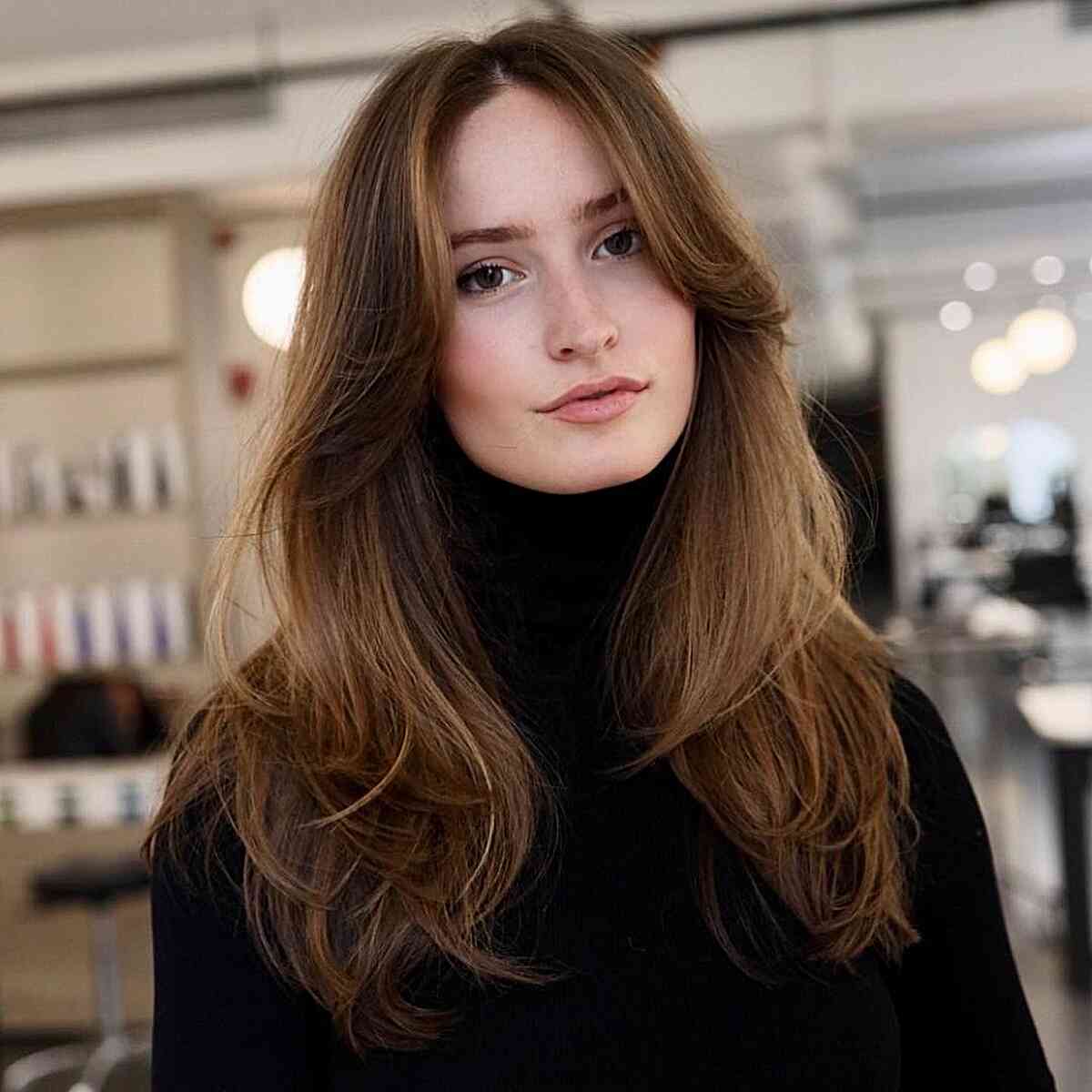
A curtain fringe can suit any face shape with some customization by your hairstylist. Be sure to determine your face shape and consider my tips below. Bonus pro tip: ask your stylist to confirm your face shape during the consultation!
- Diamond face shapes are a perfect match for curtain bangs. Slightly shorter lengths will balance your features the best. Avoid longer options that hit at your cheekbones. Any length between just touching your brows to skimming your eyelashes will look gorgeous.
- Heart-Shaped faces should avoid blunt curtain bangs, which can make your chin look too narrow. So instead, try a swoopy curtain bang that barely covers your eyebrows. This creates the illusion of an oval face shape.
- Oval face shapes can wear any type of bangs. If you’ve never had fringe, start with a less dramatic wispy version. For maximum drama, try heavy curtain bangs that skim the tops of your eyebrows.
- Round face shapes look best with textured, wispy curtain bangs. This will help elongate your face and reduce any unwanted fullness in your cheeks.
- Square face shapes enjoy added softness and femininity with shorter curtain bangs. Short, wispy ends that barely skim the top of your eyebrow will be ideal.
- Rectangle face shapes look most balanced with longer curtain bangs. Too short will make your face look disproportionately long. So, the shortest pieces should graze your cheekbones and then blend into longer face-framing layers.
How to Cut Curtain Bangs at Home: Step-By-Step
As a hairdresser, I have to say cutting your own bangs isn’t easy—not even for me! If I insist on doing mine at home, I find that I have to make tweaks and cut more for the next few days. So, you’re going to get the best curtain bangs by visiting a salon. But if for one reason or another, you have to do it yourself, I can tell you how.
1. If you already have bangs, carefully section them out from the rest of your hair. If you don’t, use a comb to section out a rainbow-shaped section of hair in front. The arch of the rainbow should only extend about 1 to 1.5 inches back from your hairline.
2. Clip the rest of your hair back or put it in a tight, low ponytail. It’s important to make sure this hair stays out of your way and can’t be cut accidentally.
3. Decide how long you want them to be. Always err on the side of caution—it is so easy to cut your own bangs way too short. Hold the section flat against your nose between your index and middle finger. Cut below your fingers in a straight line.
4. Use your fingers to measure the hair at both “ends” of your rainbow section. They need to be the same length.
5. Part your fringe section down the middle. You should now have two sections that are basically triangle shaped.5. Grab one of your triangles and pinch the hair between your middle and index fingers. Over-direct this hair to the opposite side of your face, with it still in your fingers. The angle of your fingers should be parallel to the angle of your jawline on the side you’ve over-directed to.
6. You should now see part of this section is longer, while part is shorter. Be sure not to cut the shortest part any shorter, and trim the rest of this section to match that length.
7. Repeat on the other side.
8. Blow-dry and check out your handiwork! Try to check your bangs in the mirror over the next few days for any long spots or spots that aren’t falling the right way. Carefully point-cut these when you find them, and your curtain bangs should be perfect in no time.
How to Perfectly Style Your Curtain Bangs
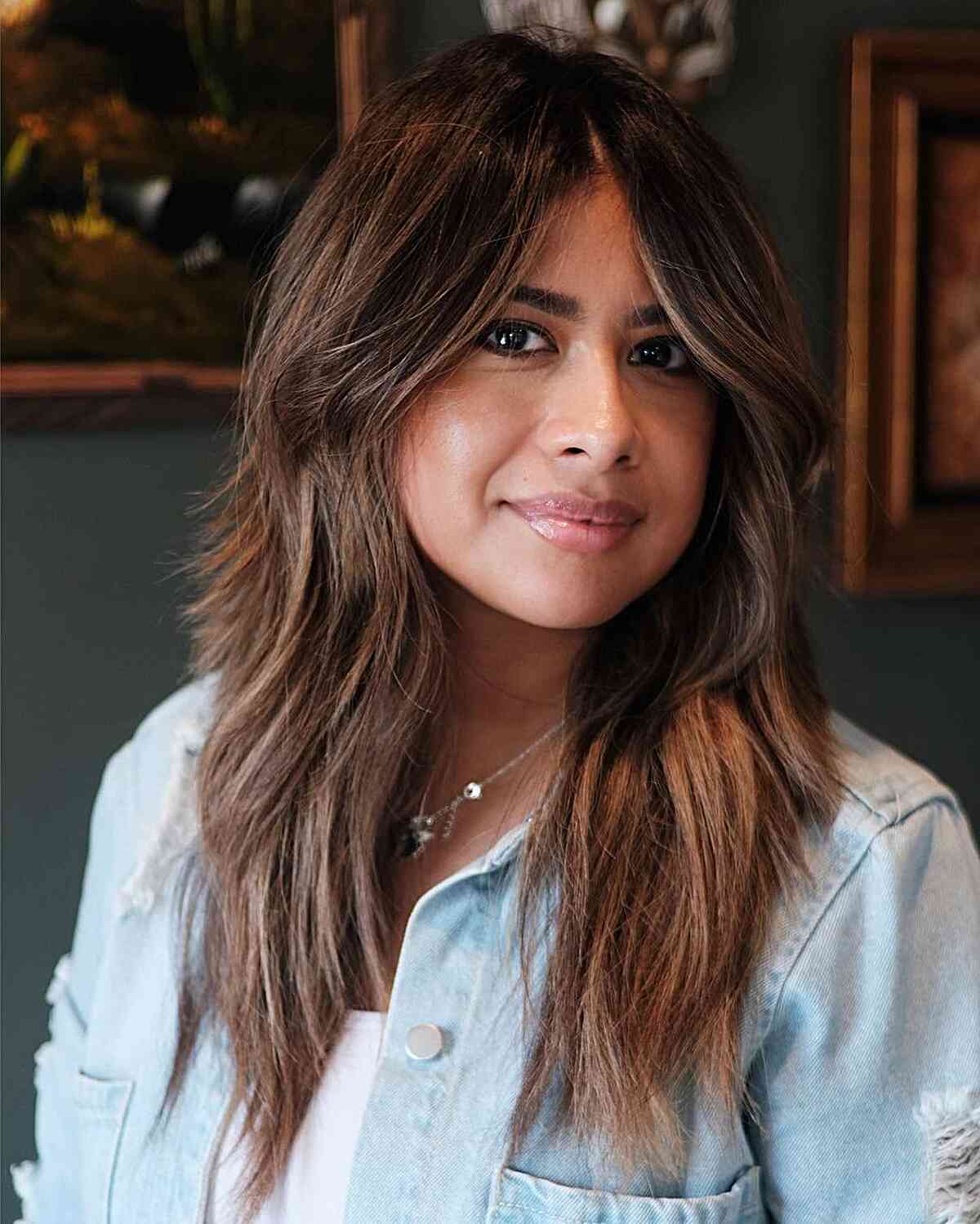
Curtain bangs almost always need a bit of daily styling. But with the right products and techniques, you can get them looking great in about 5 minutes or so. And the more experienced you get with styling your fringe, the faster it’ll be each day!
My Favorite Hair Products for Curtain Bangs
Finding the right products for styling bangs can be a little frustrating. You want something that creates all-day hold, but you don’t want your bangs to be greasy or crunchy. I’ve found a couple products that achieve this perfect balance!

My top pick is Amika Plus Size Perfect Body Mousse. It’s a great product because it adds volume and fullness without the typical downsides of mousse. I use this not just on my bangs, but my entire head of hair. Simply dispense into your hands and work through your hair from roots to ends.

For a more budget-friendly option, I also love Paul Mitchell Extra Body Sculpting Foam. You apply this one the same way as the Amika mousse. The only thing with this one is that it’s possible to use too much, and it’s not quite as volumizing.So, start with a small amount first, and style as desired. Then you can fine-tune the right amount without risking a day of crunchy hair.
Styling Techniques
First, I asked Rose for a basic explanation of how to style curtain bangs. She told me, “When styling your curtain bangs, blow-dry your hair around a brush, swoop down in the front of your face, then out towards your ear to shape it.”And this method will work for any variety or length of curtain bangs. It’s easiest to do this with a round brush, but you can get by with a paddle brush too.
Blow Drying – You should also check your blow-dryer for a “cool” option. If yours has this feature, first blow-dry them on regular heat. Then spend a minute doing the same motions Rose mentioned with cool air. Cooling down your warm hair helps lock in the style and movement all day.
Flat iron styling – Blow-drying may be enough to make your bangs look great. But if not—or you aren’t washing your hair this morning—feel free to flat iron.The easiest way is by parting your bangs down the middle first. You’ll do one half at a time. Lift half of your bangs straight up from your head, and start flat ironing at the roots. As you do so, draw an arch shape with your hand (and the flat iron). The arching movement will add the slightly swoopy curtain effect to your bangs.
You can also mist them with a hint of hairspray after flat ironing to help hold the volume in place.
What to Expect for Curtain Bangs Maintenance

Maintenance for curtain bangs can fall anywhere on a wide spectrum. Some women like to get them trimmed up once a month like clockwork. If you want yours to stay a specific length, you’ll need to do so too. But if you don’t mind wearing your bangs a bit longer, you can space out your bang trims more. You can usually go for about 3 months before they really start to lose their shape. At that point, they look more like long side bangs or face-framing layers. For maximum impact, curtain bangs need daily styling. When I first tried this style, it took me about 10 minutes to get them absolutely perfect each morning. (And I’m a major perfectionist, so it might not take you as long.) Now, I hit them with a bit of dry shampoo and brush that through. Then I spend maybe 2 minutes flat ironing them, and I’m good to go. Basically, just know that styling curtain bangs can be a bit of a learning curve. But no matter how fast you get, you’ll need to spend at least a couple minutes on them each morning. Feel free to ask your stylist to demonstrate how you can recreate the look at home.
Talking with Your Stylist About Curtain Bangs
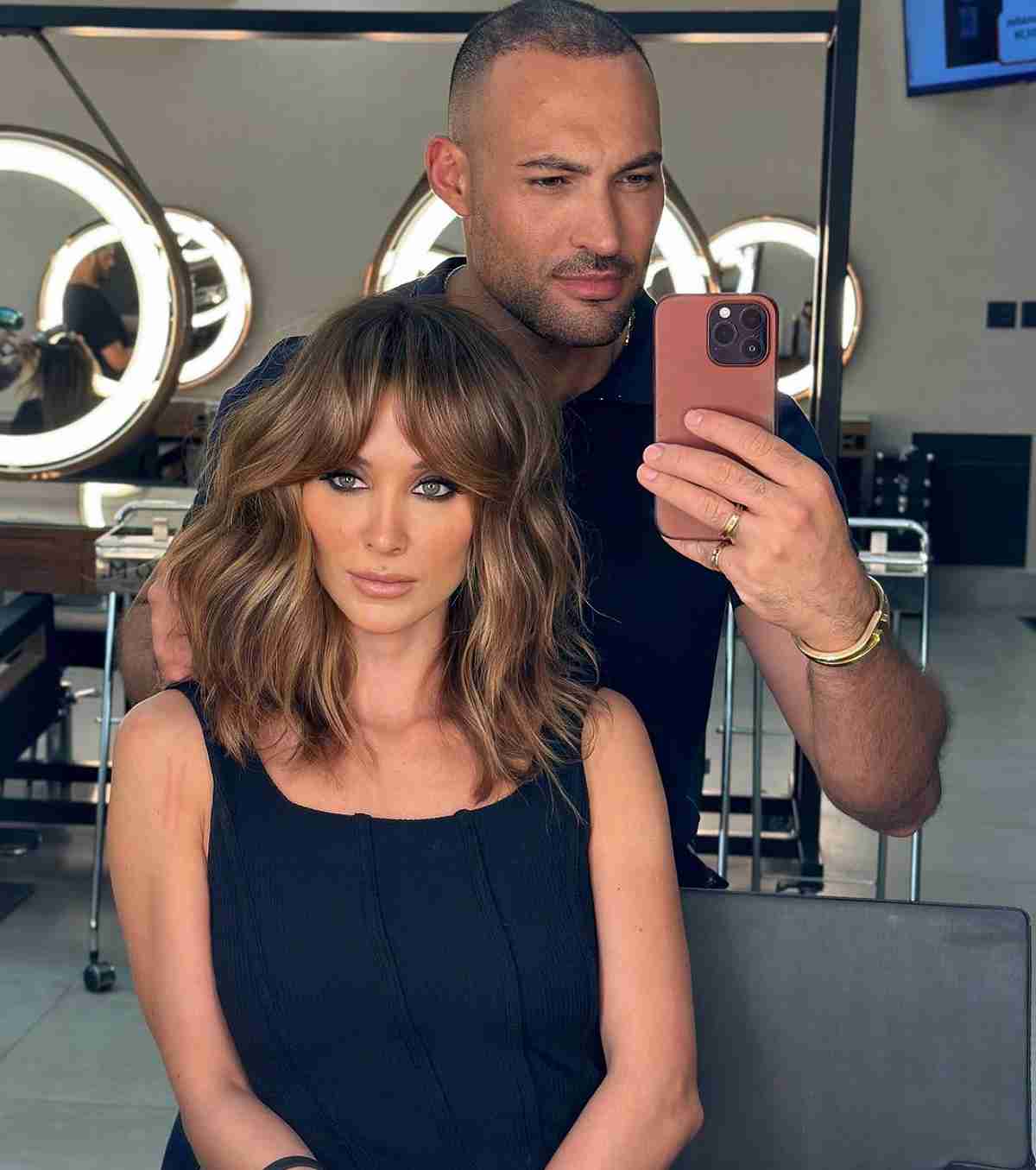
As you now know, curtain bangs can be extremely flattering on any face shape. And while there will always be some degree of maintenance, certain customizations can reduce the upkeep quite a bit. The secret to both is having a good consultation with your stylist. That’s why next, I’m sharing topics to cover before making the chop.
Have You Ever Had Bangs Before?
This is by far the biggest thing you should mention to your hairdresser when it comes to curtain bangs. Like any new hairstyle, they can radically change your appearance—for the better! At the right length, this fringe can accentuate your favorite features and hide things you don’t love. But if you’ve never had bangs before, you may be in for a shock. Psychology teaches us that our hair plays a vital role in our self-esteem. (Source) And curtain bangs can indeed highlight your best features. But they’re still a whole new look that you’ll need to adjust to.If you’ve had bangs before, you already have an idea of how they can affect your appearance. Whether your bangs have completely grown out or you’re shifting your fringe to curtain bangs, you can accurately envision the outcome.But if you’ve never had bangs before, it’s a big change. Covering your forehead and framing your face is going to make you look different. And even if you look great, it takes time to adjust to the change.I’m sharing all this info just to illustrate the importance of telling your stylist either way. Especially if you’re a regular client of the stylist cutting your bangs, they know how much you do (or don’t) change up your style from time to time. They can suggest easing into it or starting with a longer version to keep you from being shocked.
Desired Effect vs. Upkeep
Balancing the desired effect with upkeep can be tricky. If you always want your curtain bangs to hit at about your eyebrow, for example, you’ll need trims every month or two. And visiting the salon that often may or may not work for you. Talk with your stylist about the benefits you most want from your curtain bangs. But you also need to discuss how much upkeep you can realistically do. As hairdressers, we’re trained to use this info to cut your hair just right. I have clients who don’t want their curtain bangs too long, but they also don’t have time for trims more than a few times a year. Most of them prefer that I cut their bangs a little short, which gives them more time before they fully grow out. I’m not saying this is the only solution, of course. It’s one example of the many ways your hairdresser can customize your curtain bangs.
The Best Ways to Wear Curtain Bangs
Would you have guessed there was so much to know about curtain bangs? We’ve covered a lot of information today! But now you know absolutely everything worth considering before you get curtain bangs. Check out the gallery below for some of the best ways to get curtain bangs. Save your favorite photo (or photos) to show your hairstylist and enjoy your new look!
 ↓ Jump to Photo Gallery
↓ Jump to Photo Gallery

